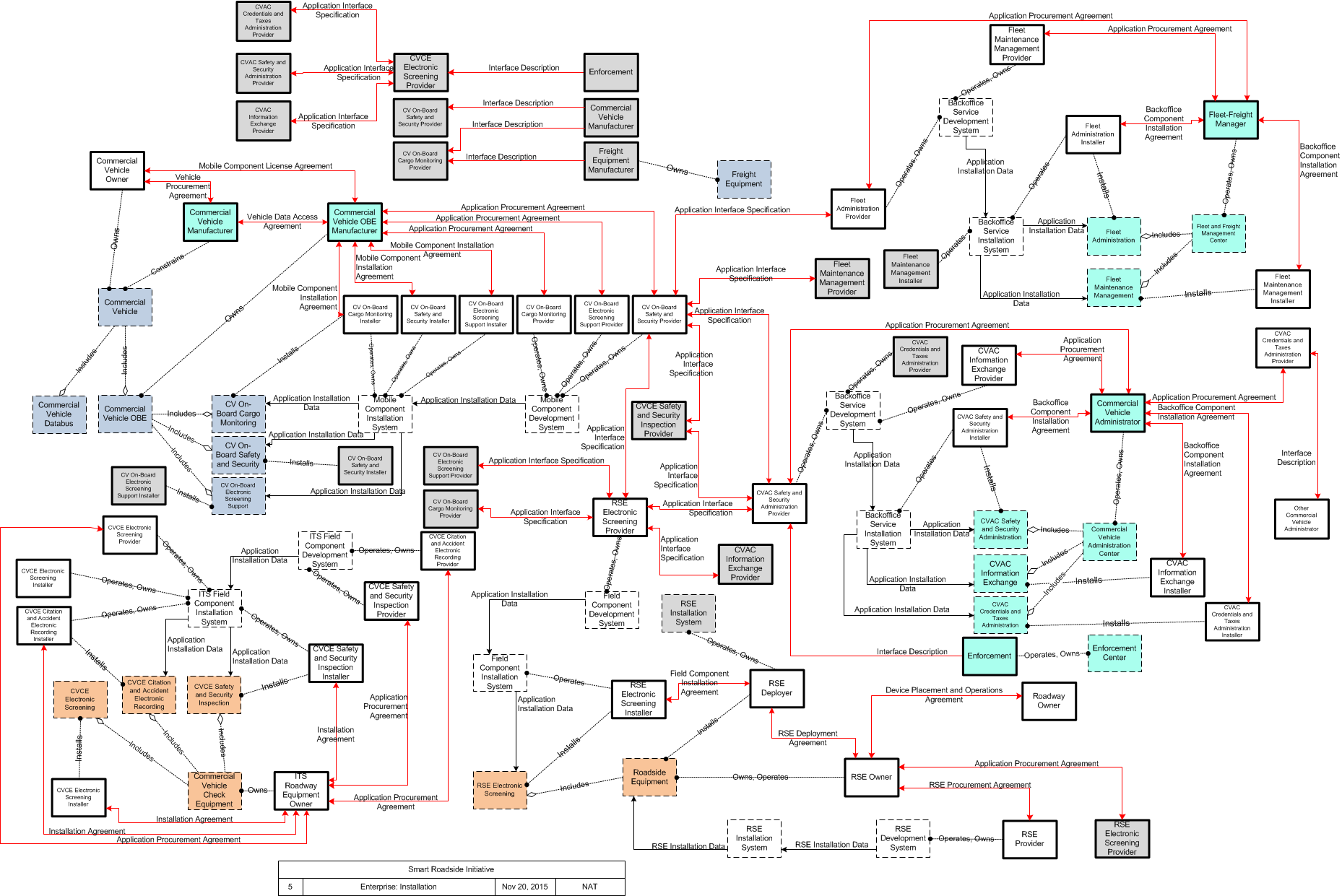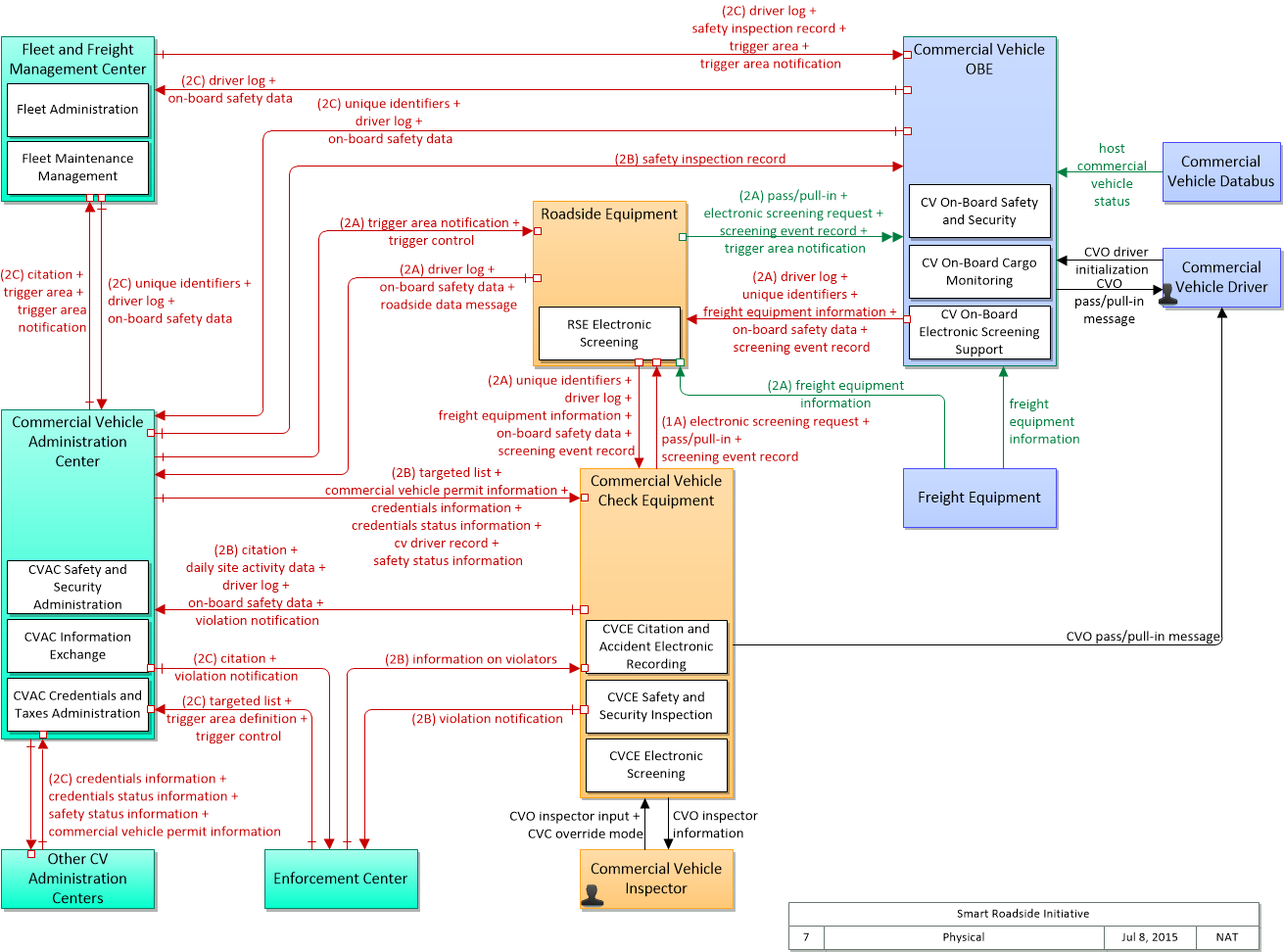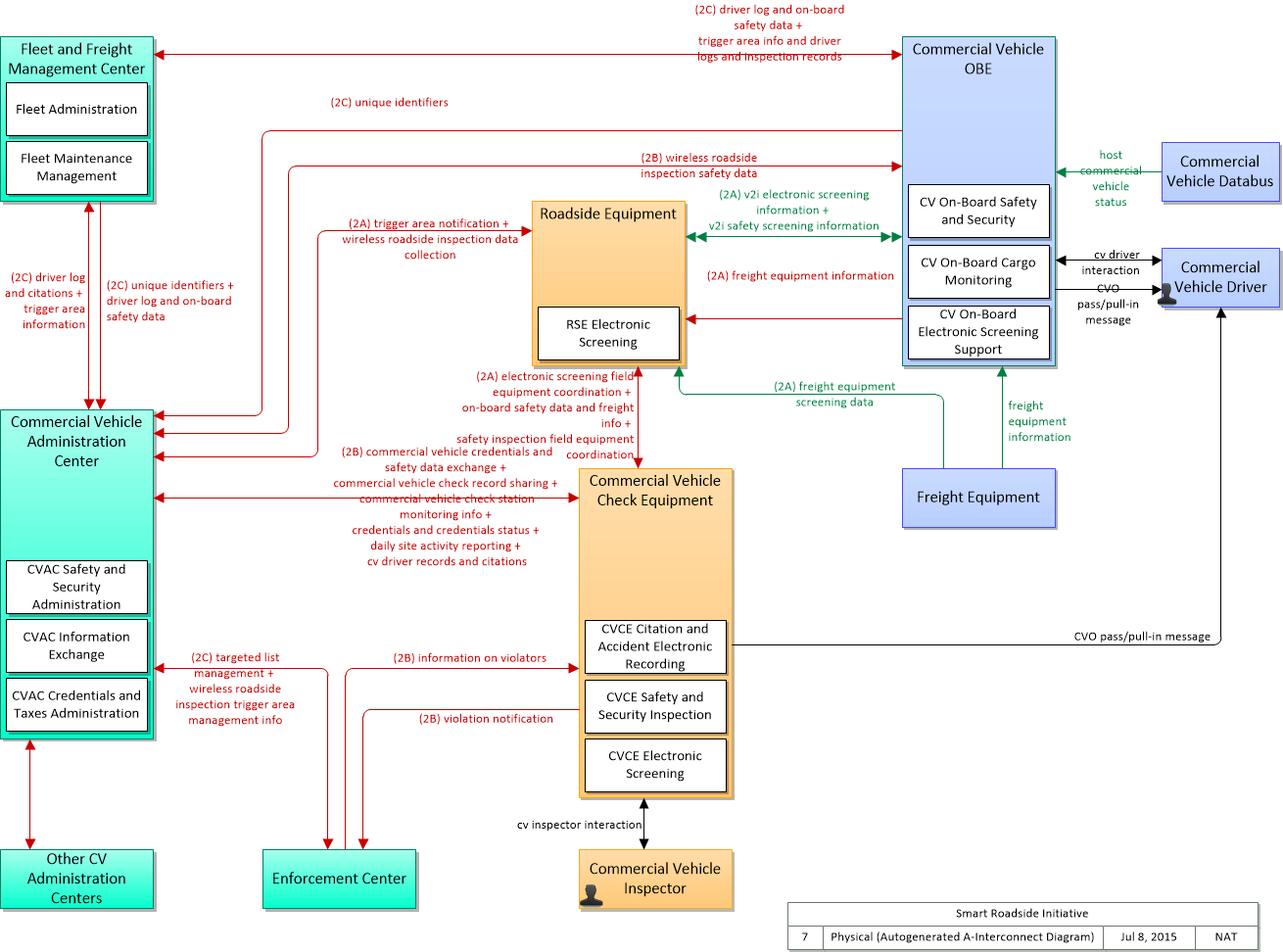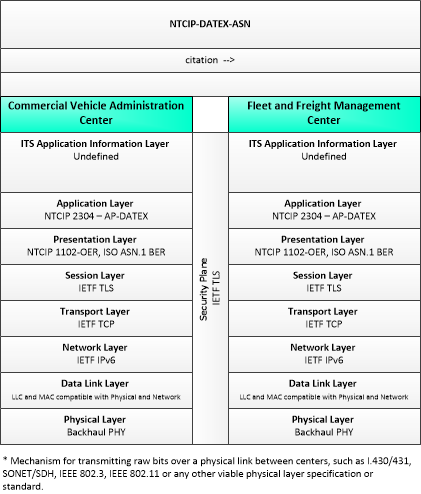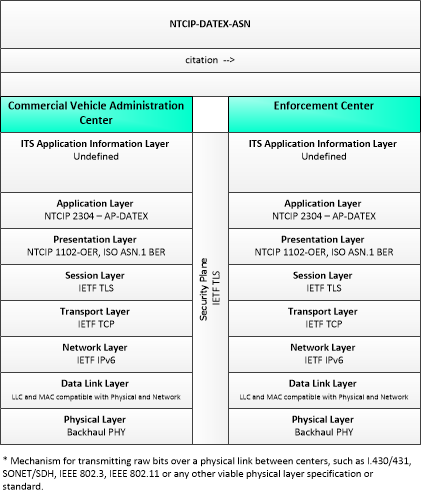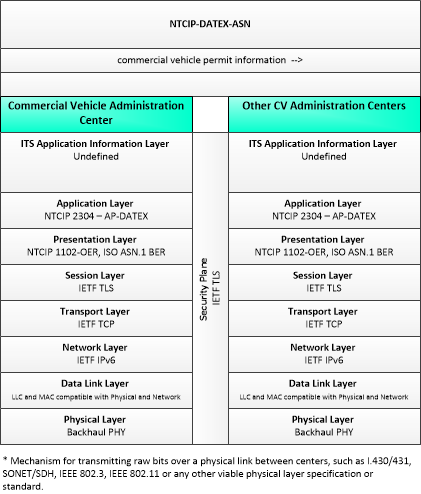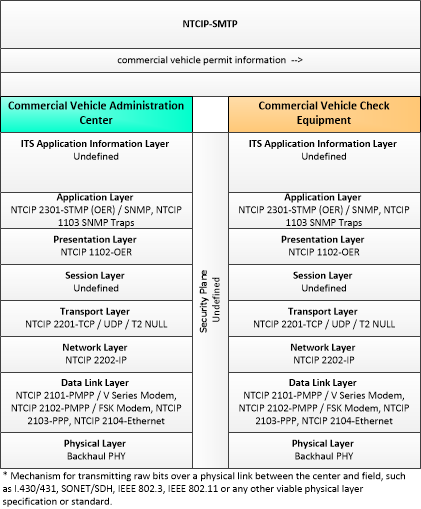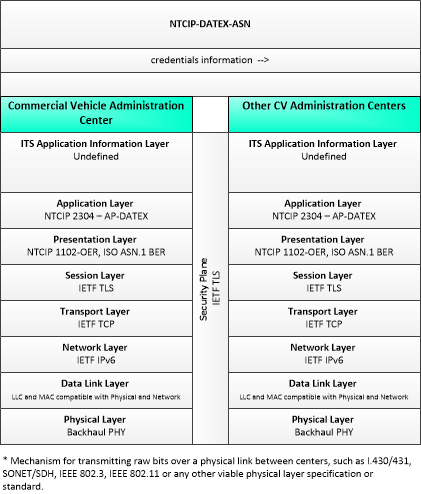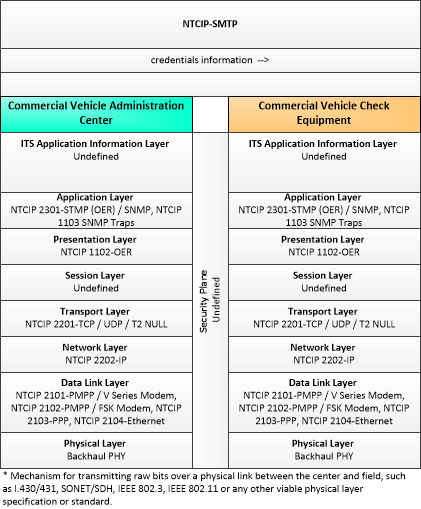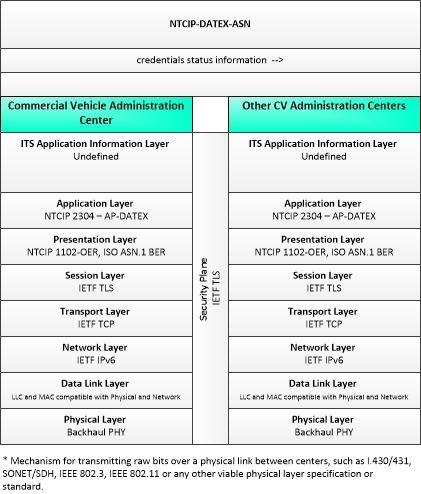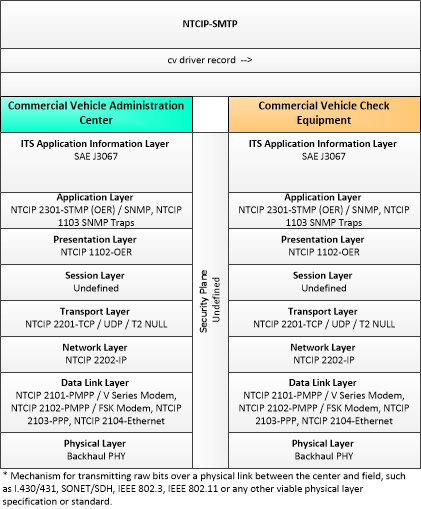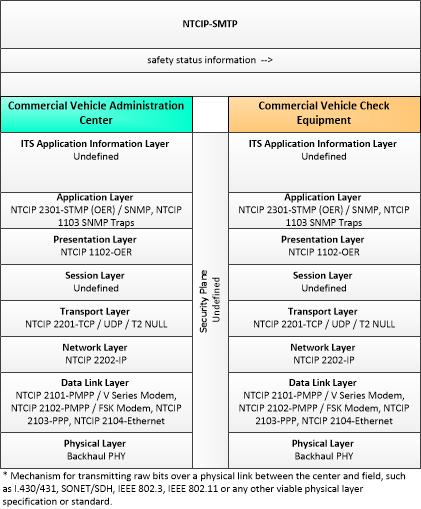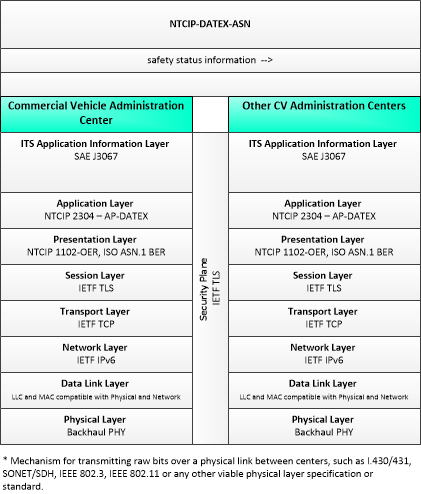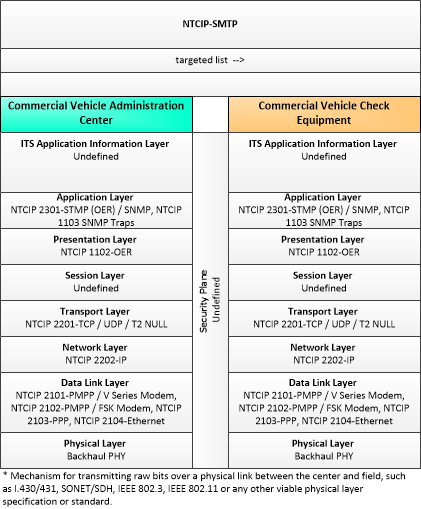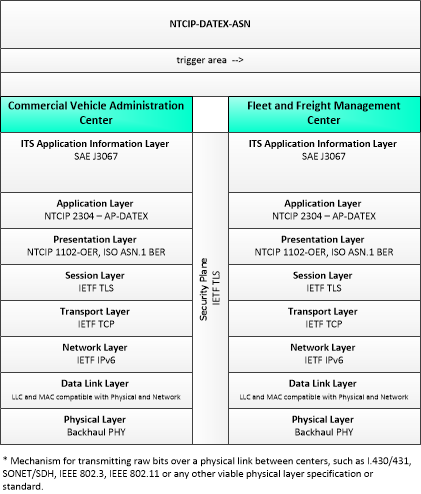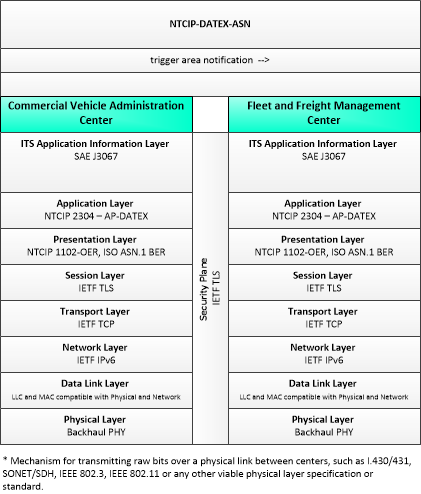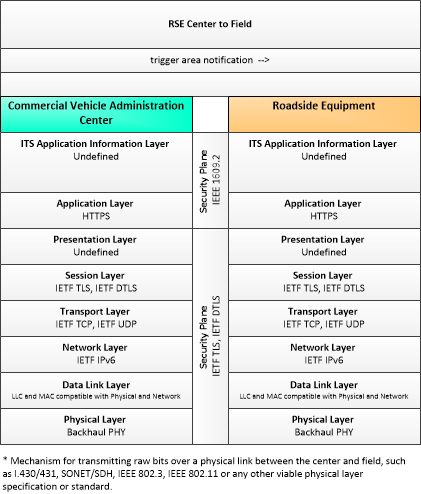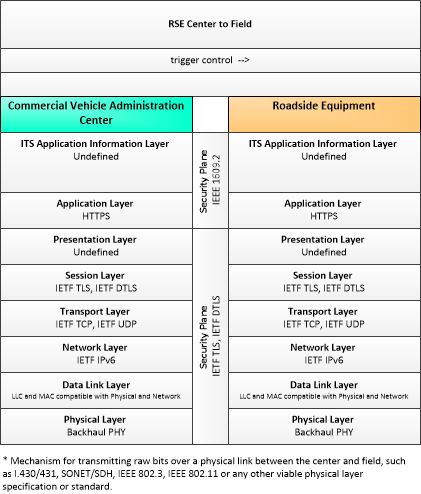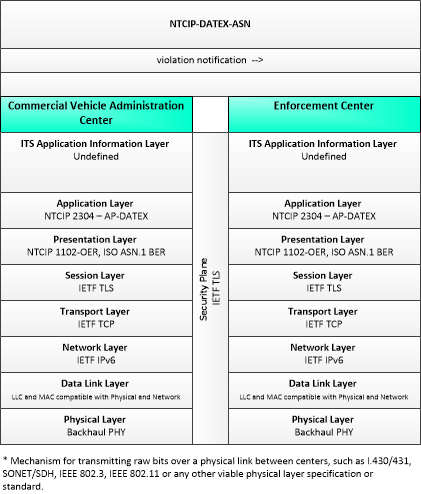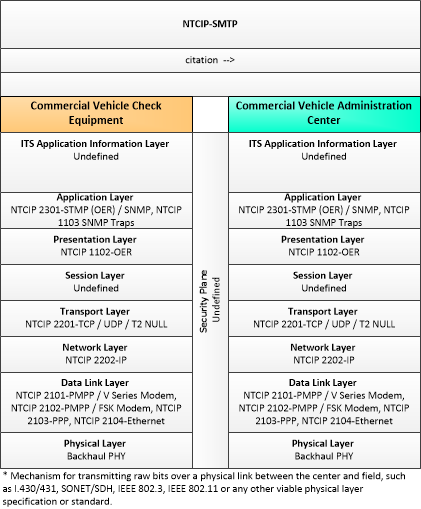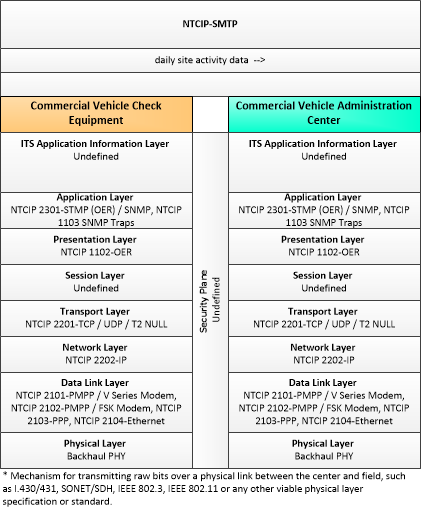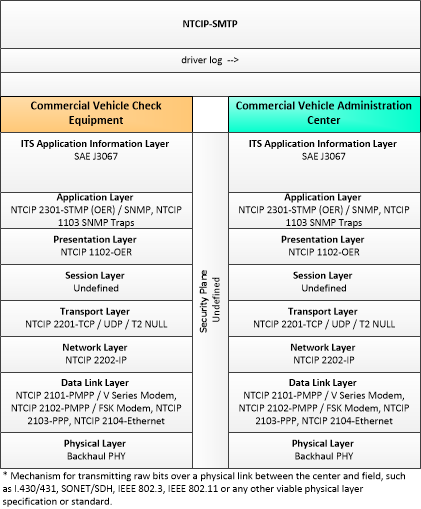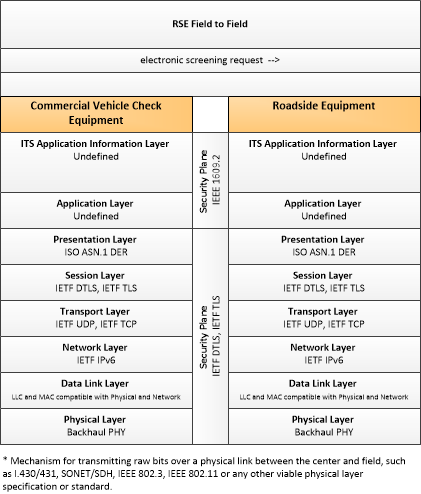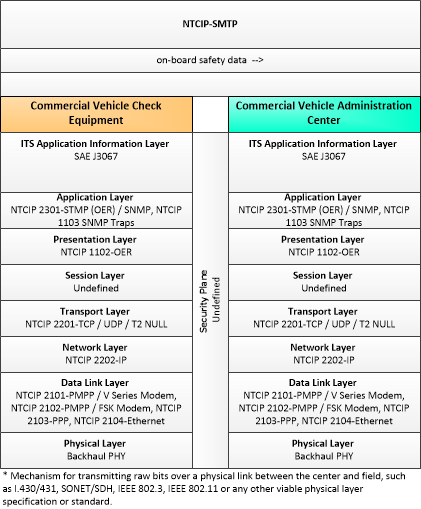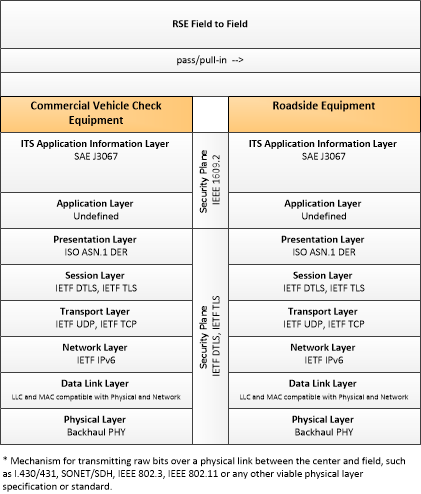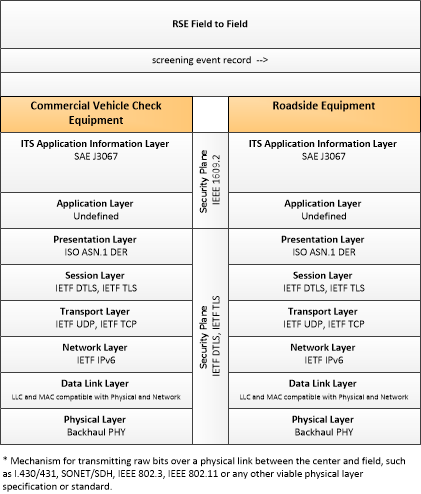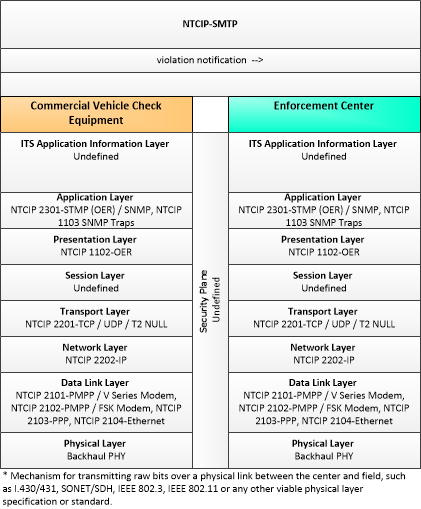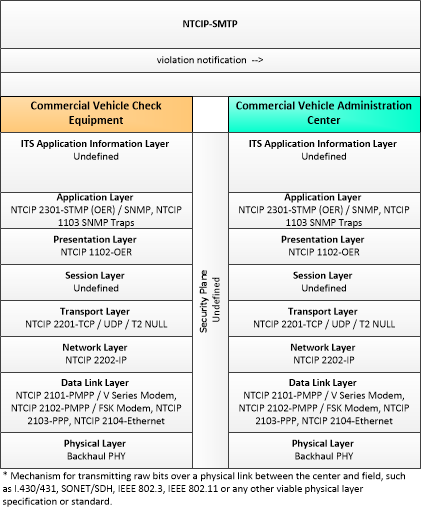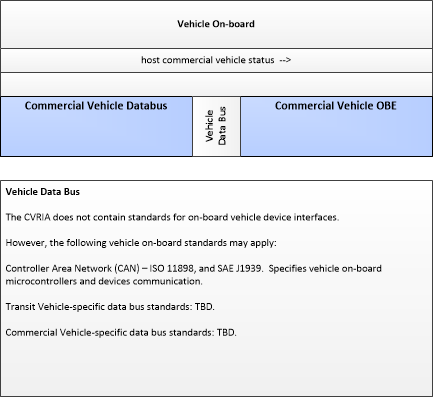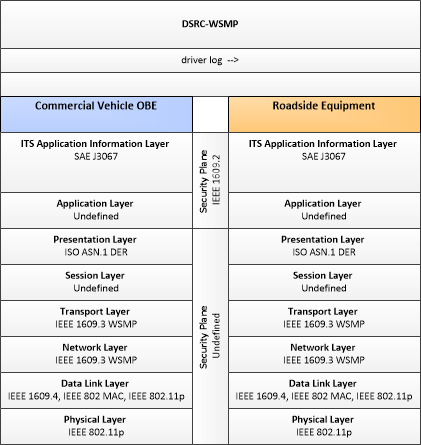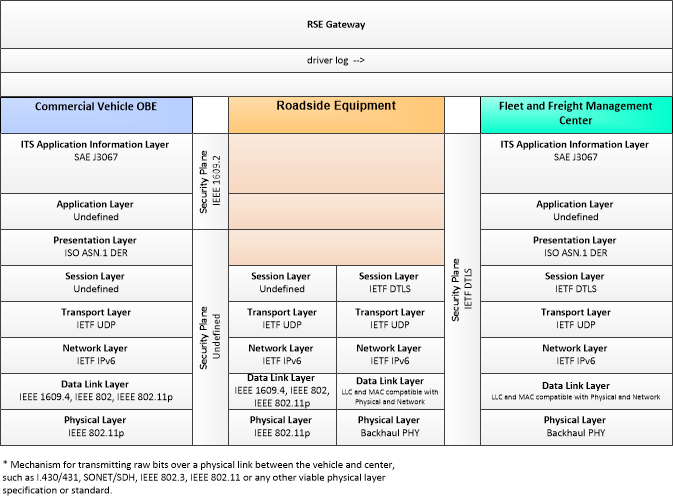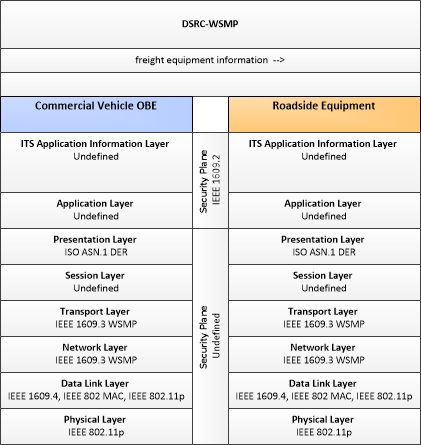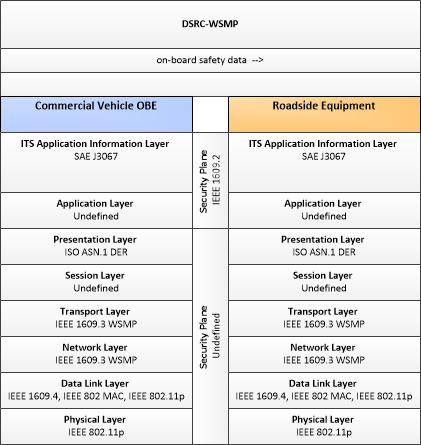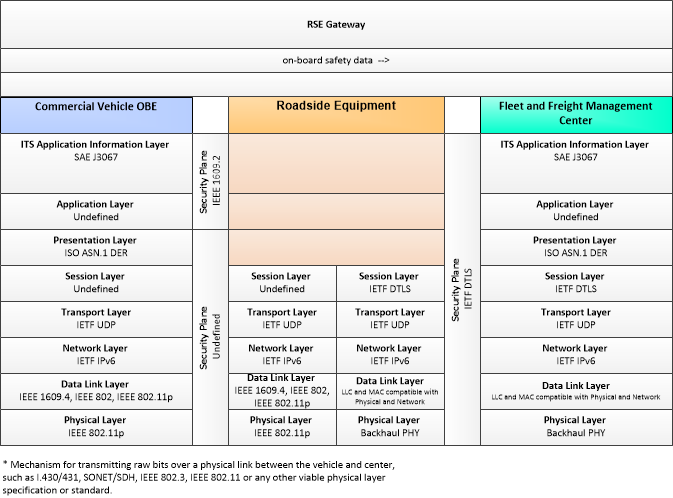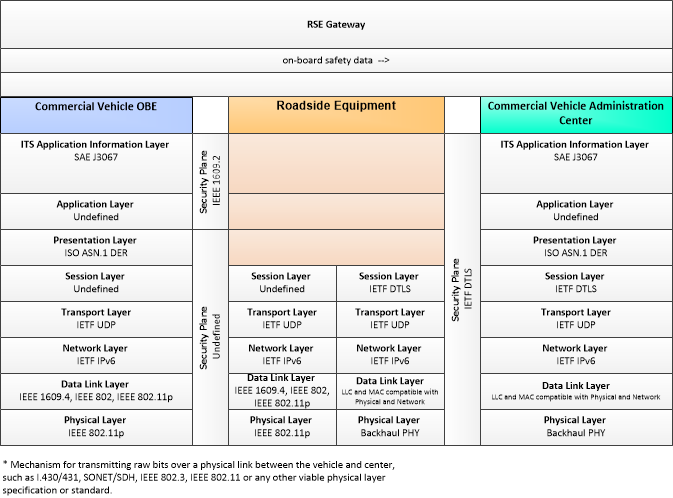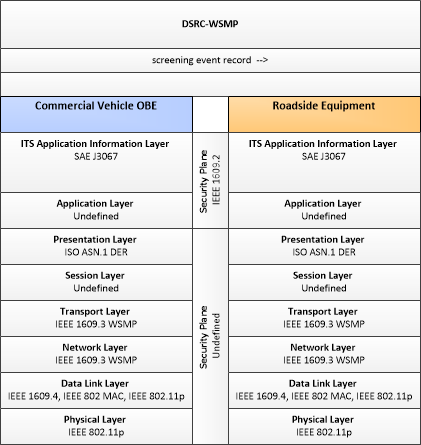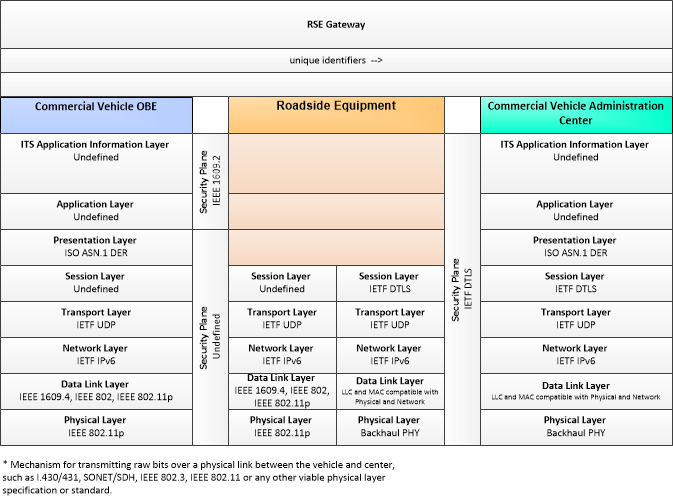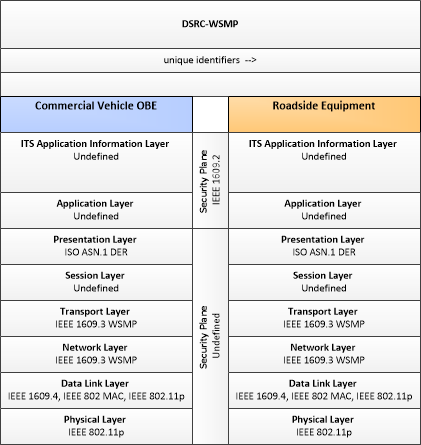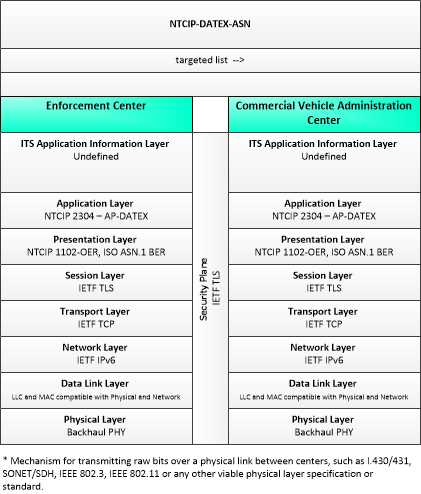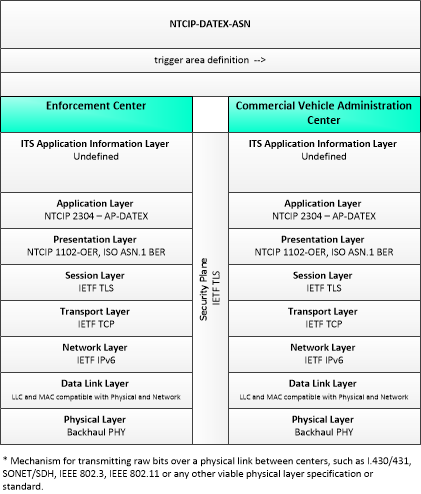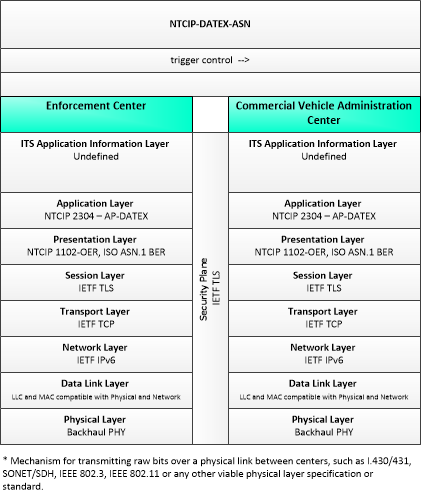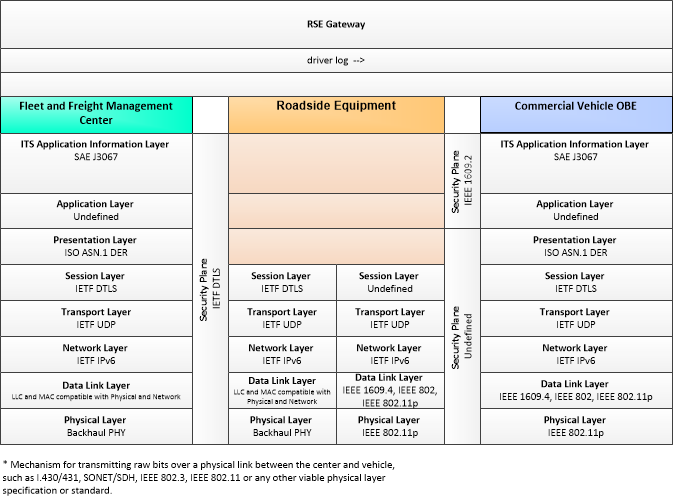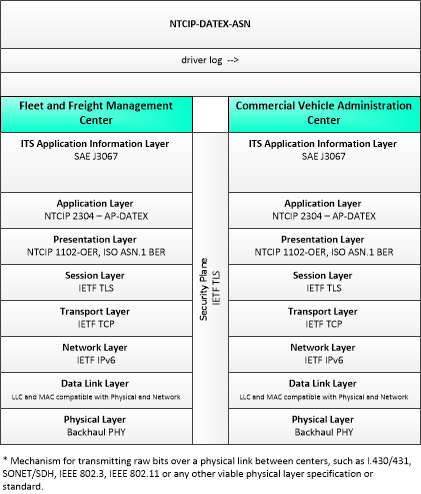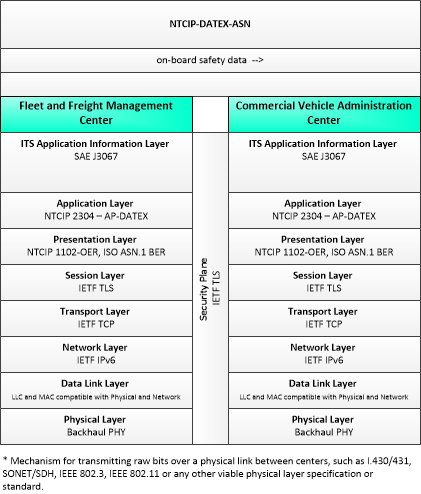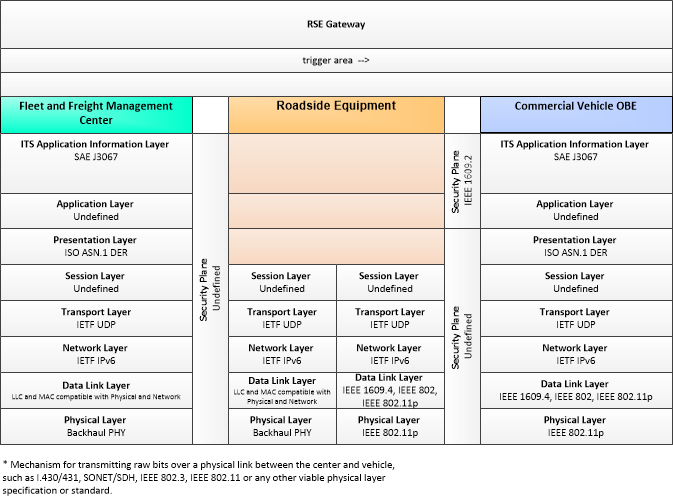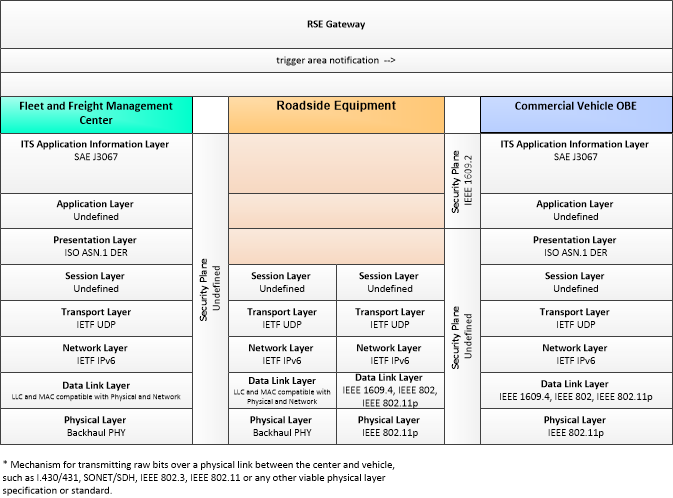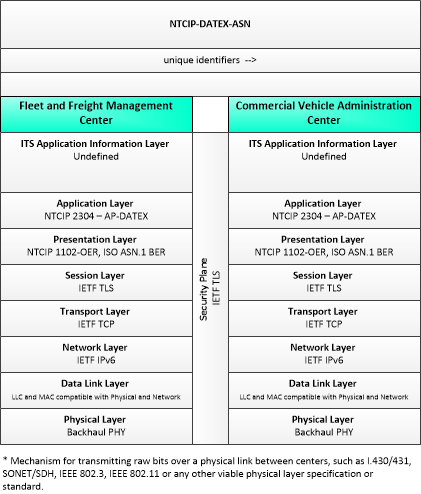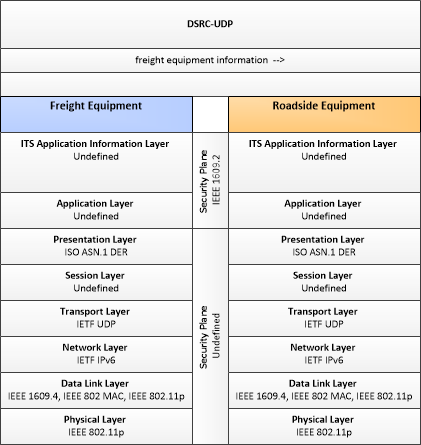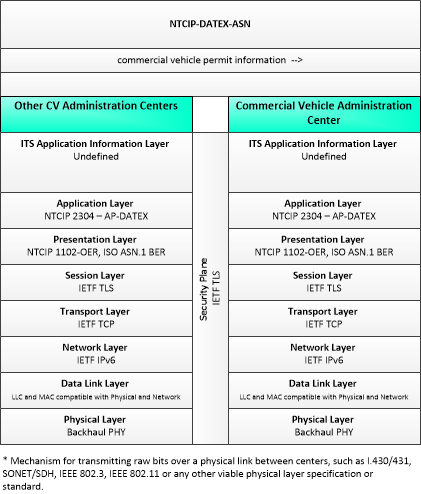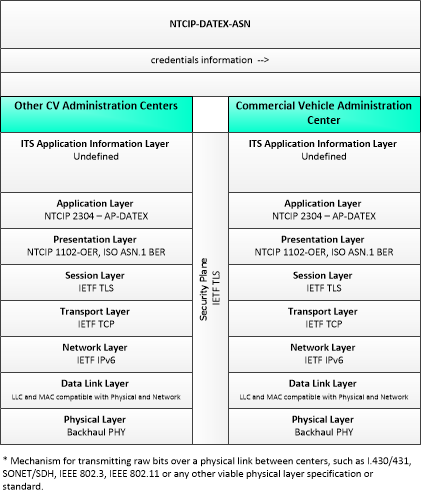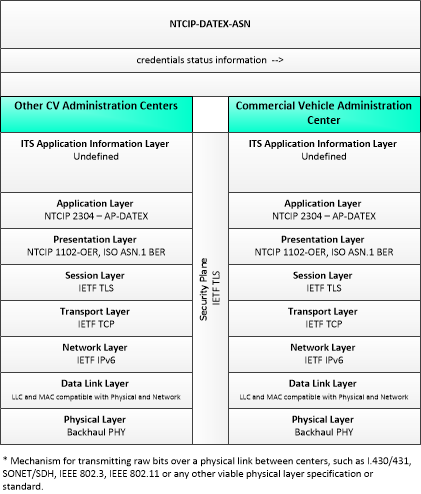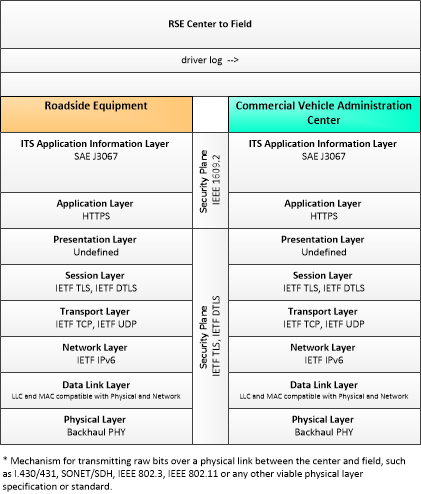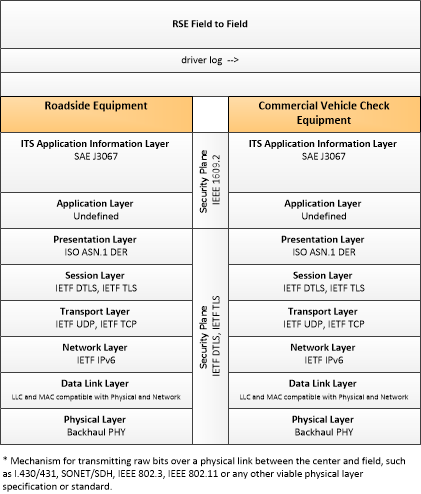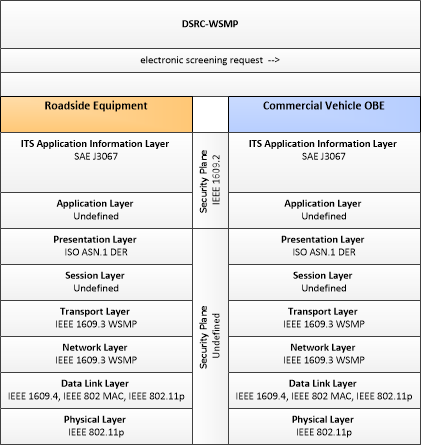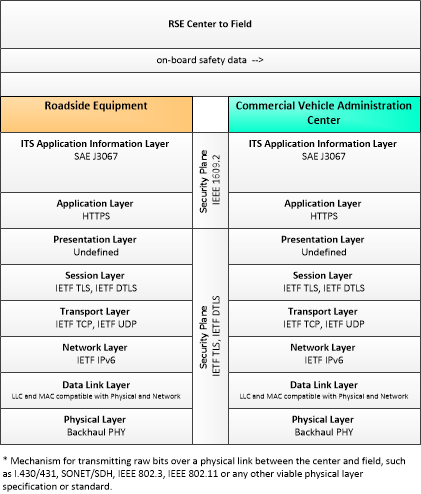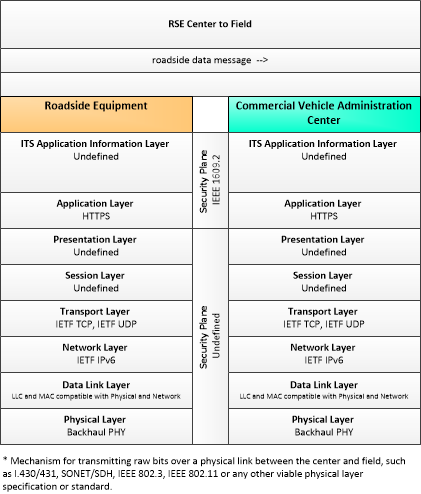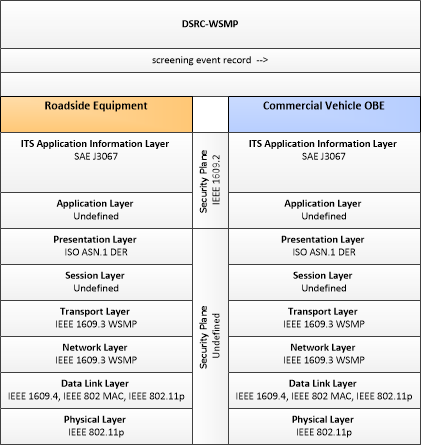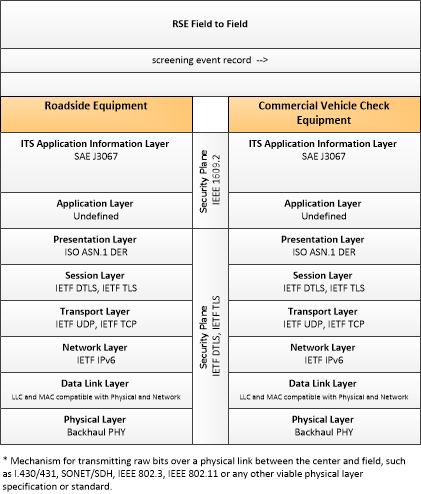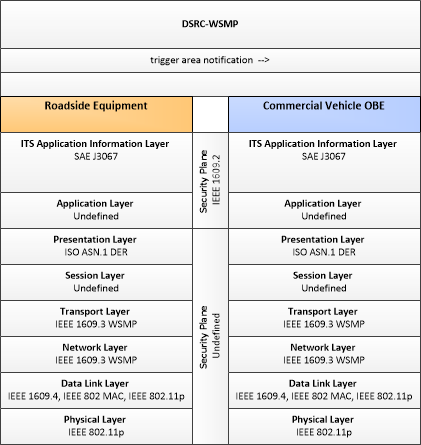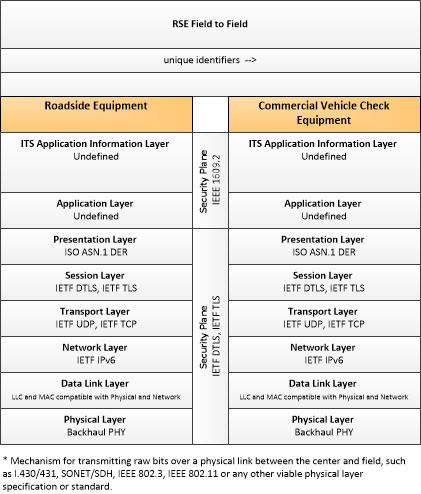Type: Mobility
Groups:- Commercial Vehicle Roadside Operations
Smart Roadside Initiative
The Smart Roadside Initiative (SRI) application describes a set of capabilities intended to improve the efficiency and safety of the Nation's roadways by providing for the exchange of important safety and operational information regarding commercial vehicles. SRI includes the delivery of capabilities related to wireless roadside inspections and electronic screening/virtual weigh stations, as well as the enabling capability of determining via electronic communications the commercial motor vehicle(CMV) identification. The wireless roadside inspection is defined by a safety screening capability that employs communications technologies to obtain information from a commercial vehicle that will allow safety screening of the vehicle and its driver. This capability provides for the interrogation at mainline speeds of a commercial vehicle when it has entered a control segment or geofenced area. Vehicle identification and driver information are provided to the roadside unit. The information communicated can be used to verify compliance with safety requirements, allowing a decision to be made regarding whether the vehicle should pull in to a roadside check station. A more advanced version of this application would download safety information measured on the vehicle including driver related information such as the driver log allowing real time evaluation that the vehicle and driver are meeting safety requirements. The electronic screening/virtual weigh stations capability employs communications technologies to obtain information from a commercial vehicle that will allow verification of permits or credentials for the vehicle. The capability provides for the interrogation at mainline speeds of a commercial vehicle when it has entered a control segment or geofenced area. Vehicle identification is provided to the roadside unit. Driver information may also be provided. The information communicated is used to verify compliance with credentials requirements, allowing a decision to be made regarding whether the vehicle should pull in to a roadside check station. This application can also be used to verify that the commercial vehicle meets vehicle weight (via weigh in motion capability) or dimension requirements. In this case sensors at the roadside measure the vehicle weight, length, or height and a pull-in request can be made if these do not meet requirements. One additional aspect of SRI, providing information on truck parking is described in the CVRIA by the Freight -Specific Dynamic Travel Planning application.
Enterprise
SVG Diagrams: Installation Operations Maintenance Certification
PNG Diagrams: Installation Operations Maintenance Certification

Business Interaction Matrix:
| Smart Roadside Initiative Operations Stage | |||||||||||||||||
|---|---|---|---|---|---|---|---|---|---|---|---|---|---|---|---|---|---|
| Roadway Owner | RSE Owner | RSE Operator | ITS Roadway Equipment Owner | Fleet-Freight Manager | Commercial Vehicle Owner | Freight Equipment Owner | Commercial Vehicle Driver | Enforcement | RSE Electronic Screening Provider | Commercial Vehicle Administrator | Commercial Vehicle Inspector | Other Commercial Vehicle Administrator | ITS Roadway Operator | CV On-Board Cargo Monitoring Provider | CV On-Board Safety and Security Provider | CV On-Board Electronic Screening Support Provider | |
| Roadway Owner | Service Delivery Agreement | ||||||||||||||||
| RSE Owner | Service Delivery Agreement | Operations Agreement | Information Exchange and Action Agreement | Application Usage Agreement | |||||||||||||
| RSE Operator | Operations Agreement | Expectation of Data Provision | |||||||||||||||
| ITS Roadway Equipment Owner | Information Exchange and Action Agreement | Expectation of Information Provision | Information Exchange and Action Agreement | Operations Agreement | |||||||||||||
| Fleet-Freight Manager | Information Exchange and Action Agreement | ||||||||||||||||
| Commercial Vehicle Owner | Expectation of Data Provision | Information Exchange and Action Agreement | Expectation of Information Provision | Vehicle Operating Agreement | Information Exchange Agreement | Application Usage Agreement | Application Usage Agreement | Application Usage Agreement | |||||||||
| Freight Equipment Owner | Expectation of Information Provision | ||||||||||||||||
| Commercial Vehicle Driver | Expectation of Information Provision | Vehicle Operating Agreement | |||||||||||||||
| Enforcement | Information Provision Agreement | ||||||||||||||||
| RSE Electronic Screening Provider | Application Usage Agreement | ||||||||||||||||
| Commercial Vehicle Administrator | Information Exchange and Action Agreement | Information Exchange Agreement | Information Provision Agreement | Information Exchange Agreement | |||||||||||||
| Commercial Vehicle Inspector | Employment Agreement | ||||||||||||||||
| Other Commercial Vehicle Administrator | Information Exchange Agreement | ||||||||||||||||
| ITS Roadway Operator | Operations Agreement | Employment Agreement | |||||||||||||||
| CV On-Board Cargo Monitoring Provider | Application Usage Agreement | ||||||||||||||||
| CV On-Board Safety and Security Provider | Application Usage Agreement | ||||||||||||||||
| CV On-Board Electronic Screening Support Provider | Application Usage Agreement | ||||||||||||||||
Includes Enterprise Objects:
| Enterprise Object | Description |
|---|---|
| Application Certification Entity | The body that determines whether an application may be deployed and operated in the Connected Vehicle Environment. This entity's composition, the requirements it applies and the procedures it uses to verify those requirements may vary with application type. For example, applications with human safety component (crash avoidance, movement assistance etc.) may have stringent requirements and extensive testing in a variety of conditions, while applications that provide strictly mobility functionality may have far less testing requirements; possibly as little as just making sure the application doesn't interfere with any other applications. |
| Commercial Vehicle Administrator | The organization responsible for the administration functions performed by the Commercial Vehicle Administration Center. |
| Commercial Vehicle Driver | The 'Commercial Vehicle Driver' represents the people that operate vehicles transporting goods, including both long haul trucks and local pick-up and delivery vans. This physical object is complementary to the Driver physical object in that it represents those interactions which are unique to Commercial Vehicle Operations. Information flowing from the Commercial Vehicle Driver includes those system inputs specific to Commercial Vehicle Operations. |
| Commercial Vehicle Inspector | The people who perform regulatory inspection of Commercial Vehicles in the field. CVO Inspectors support roadside inspection, weighing, and checking of credentials either through automated preclearance or manual methods. The Commercial Vehicle Inspector is an inspection and enforcement arm of regulatory agencies with frequent direct interface with Commercial Vehicles and their Drivers. |
| Commercial Vehicle Manufacturer | The entity which builds commercial vehicles, including long haul trucks and local pick up and delivery vehicles. This entity is complementary to the Vehicle Manufacturer entity in that it represents those aspects of vehicle manufacture which are unique to commercial vehicles. |
| Commercial Vehicle OBE Manufacturer | The Commercial Vehicle OBE Manufacturer is the provider of the commercial vehicle on-board equipment. This entity may design and build the OBE, or may integrate other components to form the OBE, or may use some combination of approaches to provide the on-board equipment. Since the OBE could be aftermarket, retrofit, built-in or nomadic, this entity is the one that builds whatever that-is. In some cases it may be a smart phone manufacturer, or in others a top tier parts supplier, or any other entity in the production chain, depending on the device and commercial vehicle in question. |
| Commercial Vehicle Owner | The entity that owns the commercial vehicle. This entity is complementary to the Vehicle Owner in that it represents those aspects of ownership which are unique to commercial vehicles. |
| CV On-Board Cargo Monitoring Installer | Application Component Installers are specified more by role than by function. Installers are responsible for the installation of the application component, which may require a support system, and may entail agreements and relationships between end users and application providers. |
| CV On-Board Cargo Monitoring Maintainer | Application Component Maintainers are specified more by role than by function. Maintainers are responsible for the maintenance (configuration changes, patches and updates, hardware repairs) of the application component, which may require a support system, and may entail agreements and relationships between end users and application providers. |
| CV On-Board Cargo Monitoring Provider | Application Component Providers are specified more by role than by function. Providers are responsible for the development of the application component, including initial creation, enhancement and bug fixes. Delivery of the application to the end user may require relationships with other entities (installers, maintainers) if the provider chooses not to fulfill those roles. |
| CV On-Board Electronic Screening Support Installer | Application Component Installers are specified more by role than by function. Installers are responsible for the installation of the application component, which may require a support system, and may entail agreements and relationships between end users and application providers. |
| CV On-Board Electronic Screening Support Maintainer | Application Component Maintainers are specified more by role than by function. Maintainers are responsible for the maintenance (configuration changes, patches and updates, hardware repairs) of the application component, which may require a support system, and may entail agreements and relationships between end users and application providers. |
| CV On-Board Electronic Screening Support Provider | Application Component Providers are specified more by role than by function. Providers are responsible for the development of the application component, including initial creation, enhancement and bug fixes. Delivery of the application to the end user may require relationships with other entities (installers, maintainers) if the provider chooses not to fulfill those roles. |
| CV On-Board Safety and Security Installer | Application Component Installers are specified more by role than by function. Installers are responsible for the installation of the application component, which may require a support system, and may entail agreements and relationships between end users and application providers. |
| CV On-Board Safety and Security Maintainer | Application Component Maintainers are specified more by role than by function. Maintainers are responsible for the maintenance (configuration changes, patches and updates, hardware repairs) of the application component, which may require a support system, and may entail agreements and relationships between end users and application providers. |
| CV On-Board Safety and Security Provider | Application Component Providers are specified more by role than by function. Providers are responsible for the development of the application component, including initial creation, enhancement and bug fixes. Delivery of the application to the end user may require relationships with other entities (installers, maintainers) if the provider chooses not to fulfill those roles. |
| CVAC Credentials and Taxes Administration Installer | Application Component Installers are specified more by role than by function. Installers are responsible for the installation of the application component, which may require a support system, and may entail agreements and relationships between end users and application providers. |
| CVAC Credentials and Taxes Administration Maintainer | Application Component Maintainers are specified more by role than by function. Maintainers are responsible for the maintenance (configuration changes, patches and updates, hardware repairs) of the application component, which may require a support system, and may entail agreements and relationships between end users and application providers. |
| CVAC Credentials and Taxes Administration Provider | Application Component Providers are specified more by role than by function. Providers are responsible for the development of the application component, including initial creation, enhancement and bug fixes. Delivery of the application to the end user may require relationships with other entities (installers, maintainers) if the provider chooses not to fulfill those roles. |
| CVAC Information Exchange Installer | Application Component Installers are specified more by role than by function. Installers are responsible for the installation of the application component, which may require a support system, and may entail agreements and relationships between end users and application providers. |
| CVAC Information Exchange Maintainer | Application Component Maintainers are specified more by role than by function. Maintainers are responsible for the maintenance (configuration changes, patches and updates, hardware repairs) of the application component, which may require a support system, and may entail agreements and relationships between end users and application providers. |
| CVAC Information Exchange Provider | Application Component Providers are specified more by role than by function. Providers are responsible for the development of the application component, including initial creation, enhancement and bug fixes. Delivery of the application to the end user may require relationships with other entities (installers, maintainers) if the provider chooses not to fulfill those roles. |
| CVAC Safety and Security Administration Installer | Application Component Installers are specified more by role than by function. Installers are responsible for the installation of the application component, which may require a support system, and may entail agreements and relationships between end users and application providers. |
| CVAC Safety and Security Administration Maintainer | Application Component Maintainers are specified more by role than by function. Maintainers are responsible for the maintenance (configuration changes, patches and updates, hardware repairs) of the application component, which may require a support system, and may entail agreements and relationships between end users and application providers. |
| CVAC Safety and Security Administration Provider | Application Component Providers are specified more by role than by function. Providers are responsible for the development of the application component, including initial creation, enhancement and bug fixes. Delivery of the application to the end user may require relationships with other entities (installers, maintainers) if the provider chooses not to fulfill those roles. |
| CVCE Citation and Accident Electronic Recording Installer | Application Component Installers are specified more by role than by function. Installers are responsible for the installation of the application component, which may require a support system, and may entail agreements and relationships between end users and application providers. |
| CVCE Citation and Accident Electronic Recording Maintainer | Application Component Maintainers are specified more by role than by function. Maintainers are responsible for the maintenance (configuration changes, patches and updates, hardware repairs) of the application component, which may require a support system, and may entail agreements and relationships between end users and application providers. |
| CVCE Citation and Accident Electronic Recording Provider | Application Component Providers are specified more by role than by function. Providers are responsible for the development of the application component, including initial creation, enhancement and bug fixes. Delivery of the application to the end user may require relationships with other entities (installers, maintainers) if the provider chooses not to fulfill those roles. |
| CVCE Electronic Screening Installer | Application Component Installers are specified more by role than by function. Installers are responsible for the installation of the application component, which may require a support system, and may entail agreements and relationships between end users and application providers. |
| CVCE Electronic Screening Maintainer | Application Component Maintainers are specified more by role than by function. Maintainers are responsible for the maintenance (configuration changes, patches and updates, hardware repairs) of the application component, which may require a support system, and may entail agreements and relationships between end users and application providers. |
| CVCE Electronic Screening Provider | Application Component Providers are specified more by role than by function. Providers are responsible for the development of the application component, including initial creation, enhancement and bug fixes. Delivery of the application to the end user may require relationships with other entities (installers, maintainers) if the provider chooses not to fulfill those roles. |
| CVCE Safety and Security Inspection Installer | Application Component Installers are specified more by role than by function. Installers are responsible for the installation of the application component, which may require a support system, and may entail agreements and relationships between end users and application providers. |
| CVCE Safety and Security Inspection Maintainer | Application Component Maintainers are specified more by role than by function. Maintainers are responsible for the maintenance (configuration changes, patches and updates, hardware repairs) of the application component, which may require a support system, and may entail agreements and relationships between end users and application providers. |
| CVCE Safety and Security Inspection Provider | Application Component Providers are specified more by role than by function. Providers are responsible for the development of the application component, including initial creation, enhancement and bug fixes. Delivery of the application to the end user may require relationships with other entities (installers, maintainers) if the provider chooses not to fulfill those roles. |
| Device Certification Entity | The body that determines whether a device may be deployed and operated in the Connected Vehicle Environment. This entity's composition, the requirements it applies and the procedures it uses to verify those requirements may vary with device type. |
| Enforcement | Agencies that are responsible for identifying and reporting violations of roadway regulations, including emissions, traffic violations, toll violations, etc. |
| Federal Regulatory | Federal regulatory bodies that have legal authority to control and/or provide input to policies regulating transportation infrastructure and operations. This includes entities such as the Federal Communications Commission and US Department of Transportation. |
| Fleet Administration Installer | Application Component Installers are specified more by role than by function. Installers are responsible for the installation of the application component, which may require a support system, and may entail agreements and relationships between end users and application providers. |
| Fleet Administration Maintainer | Application Component Maintainers are specified more by role than by function. Maintainers are responsible for the maintenance (configuration changes, patches and updates, hardware repairs) of the application component, which may require a support system, and may entail agreements and relationships between end users and application providers. |
| Fleet Administration Provider | Application Component Providers are specified more by role than by function. Providers are responsible for the development of the application component, including initial creation, enhancement and bug fixes. Delivery of the application to the end user may require relationships with other entities (installers, maintainers) if the provider chooses not to fulfill those roles. |
| Fleet Maintenance Management Installer | Application Component Installers are specified more by role than by function. Installers are responsible for the installation of the application component, which may require a support system, and may entail agreements and relationships between end users and application providers. |
| Fleet Maintenance Management Maintainer | Application Component Maintainers are specified more by role than by function. Maintainers are responsible for the maintenance (configuration changes, patches and updates, hardware repairs) of the application component, which may require a support system, and may entail agreements and relationships between end users and application providers. |
| Fleet Maintenance Management Provider | Application Component Providers are specified more by role than by function. Providers are responsible for the development of the application component, including initial creation, enhancement and bug fixes. Delivery of the application to the end user may require relationships with other entities (installers, maintainers) if the provider chooses not to fulfill those roles. |
| Fleet-Freight Manager | The 'Fleet-Freight Manager' represents the people that are responsible for the dispatching and management of Commercial Vehicle fleets (e.g. traditional Fleet Managers) and Freight Equipment assets. It may be many people in a large tracking organization or a single person (owner driver) in the case of single vehicle fleets. The Fleet-Freight Manager provides instructions and coordination for Commercial Vehicles and Freight Equipment and receives the status of the vehicles and freight equipment in the fleet that they manage. |
| Freight Equipment Manufacturer | The entity that builds freight equipment. |
| Freight Equipment Owner | The entity that owns freight equipment such as a freight container, intermodal chassis or trailer. |
| ITS Certification Entity | The body that determines whether an ITS device or application may be deployed and operated in the transportation environment. This entity's composition, the requirements it applies and the procedures it uses to verify those requirements may vary with device and application type. Typically not a formal body, assigned on a project-by-project basis depending on the type of infrastructure involved. Since ITS projects are locally-focused (typically state or smaller), the entities that are part of this body are typically those with operational jurisdiction where the ITS is installed (e.g., state or local DOTs, state or local maintenance managers etc.) |
| ITS Roadway Equipment Owner | The entity that owns the Roadway ITS equipment. |
| ITS Roadway Operator | The entity that operates the Roadway ITS equipment. |
| Other Commercial Vehicle Administrator | Representing another the administrator of another Commercial Vehicle Administration Center, this object provides source and destination for flows and relationships between Commercial Vehicle Administration Centers. |
| Roadway Owner | The owner of the roadway proximate to which roadside equipment will be/is installed. |
| RSE Deployer | The entity responsible for the deployment, operations and maintenance of roadside equipment. |
| RSE Electronic Screening Installer | Application Component Installers are specified more by role than by function. Installers are responsible for the installation of the application component, which may require a support system, and may entail agreements and relationships between end users and application providers. |
| RSE Electronic Screening Maintainer | Application Component Maintainers are specified more by role than by function. Maintainers are responsible for the maintenance (configuration changes, patches and updates, hardware repairs) of the application component, which may require a support system, and may entail agreements and relationships between end users and application providers. |
| RSE Electronic Screening Provider | Application Component Providers are specified more by role than by function. Providers are responsible for the development of the application component, including initial creation, enhancement and bug fixes. Delivery of the application to the end user may require relationships with other entities (installers, maintainers) if the provider chooses not to fulfill those roles. |
| RSE Operator | The entity that operates roadside equipment in the transportation environment. |
| RSE Owner | The owner of roadside equipment. |
| RSE Provider | The "RSE Provider" is the entity that develops and (presumably) sells roadside equipment to other entities for deployment and research. |
| State Regulatory | State regulatory bodies that have legal authority to control and/or provide input to policies regulating vehicles, transportation infrastructure and operations. This includes entities like Departments of Motor Vehicles, property tax authorities and tolling agencies. |
Includes Resources:
| Resource | Description |
|---|---|
| Application Component Certification Requirements | The requirements that define the functionality, performance and operational environment of an application component. Certification Requirements must be met in order for an application to be installed in the CVE. |
| Backoffice Service Development System | The systems used to develop backoffice (center) hardware and software components of applications. |
| Backoffice Service Installation System | The systems used to install and configure backoffice (center) hardware and software components. |
| Backoffice Service Maintenance System | The systems used to maintain and upgrade backoffice (center) hardware and software components. |
| Commercial Vehicle | The commercial vehicle includes the sensory, processing, storage, and communications functions necessary to support safe and efficient commercial vehicle operations. It includes two-way communications between the commercial vehicle drivers, their fleet managers, attached freight equipment, and roadside officials, and provides HAZMAT response teams with timely and accurate cargo contents information after a vehicle incident. It can collect and process vehicle, cargo information from the attached freight equipment, and driver safety data and status and alert the driver whenever there is a potential safety or security problem. Basic identification, security and safety status data are supplied to inspection facilities at mainline speeds. In addition, it can automatically collect and record mileage, fuel usage, and border crossings. |
| Commercial Vehicle Administration Center | The 'Commercial Vehicle Administration Center' performs administrative functions supporting credentials, tax, and safety regulations associated with commercial vehicles. It issues credentials, collects fees and taxes, and supports enforcement of credential requirements. It communicates with motor carriers to process credentials applications and collect fuel taxes, weight/distance taxes, and other taxes and fees associated with commercial vehicle operations. It also receives applications for, and issues special Oversize/Overweight and HAZMAT permits in coordination with cognizant authorities. It coordinates with other Commercial Vehicle Administration Centers (in other states/regions) to support nationwide access to credentials and safety information for administration and enforcement functions. It communicates with field equipment to enable credential checking and safety information collection at the roadside. It makes safety information available to qualified stakeholders to identify carriers and drivers that operate unsafely. |
| Commercial Vehicle Check Equipment | 'Commercial Vehicle Check Equipment' supports automated vehicle identification at mainline speeds for credential checking, roadside safety inspections, and weigh-in-motion using two-way data exchange. These capabilities include providing warnings to the commercial vehicle drivers, their fleet managers, and proper authorities of any safety problems that have been identified, accessing and examining historical safety data, and automatically deciding whether to allow the vehicle to pass or require it to stop with operator manual override. Commercial Vehicle Check Equipment also provides supplemental inspection services such as expedited brake inspections, the use of operator hand-held devices, mobile screening sites, on-board safety database access, and the enrollment of vehicles and carriers in the electronic clearance program. |
| Commercial Vehicle Databus | The 'Commercial Vehicle Databus' represents the interface to the heavy vehicle databus that connects on-board systems included in the commercial vehicle. This vehicle is used to transport goods, is operated by a professional driver and typically administered as part of a larger fleet. Commercial Vehicle classification applies to all goods transport vehicles ranging from small panel vans used in local pick-up and delivery services to large, multi-axle tractor-trailer rigs operating on long haul routes. It is a specialized and extended form of the Vehicle Databus that may be subject to different vehicle databus standards and connect with a broad range of components that are specific to commercial vehicles including the systems that are used to monitor, secure, and maintain freight while enroute. As a specialized form of the Vehicle Databus, it also provides access to the general-purpose sensors (e.g., radars, cameras), GPS, drive train monitoring and control systems, and vehicle safety features that support connected vehicle applications. |
| Commercial Vehicle OBE | The Commercial Vehicle On-Board Equipment (OBE) resides in a commercial vehicle and provides the sensory, processing, storage, and communications functions necessary to support safe and efficient commercial vehicle operations. It provides two-way communications between the commercial vehicle drivers, their fleet managers, attached freight equipment, and roadside officials. In CVRIA, a separate 'Vehicle OBE' physical object supports the general V2V and V2I safety applications and other applications that apply to all vehicles, including commercial vehicles. The Commercial Vehicle OBE supplements these general capabilities with capabilities that are specific to commercial vehicles. |
| CV On-Board Cargo Monitoring | "CV On-Board Cargo Monitoring" monitors the location and status of the commercial vehicle and its cargo. It sends the collected data to appropriate centers and roadside facilities, including emergency management in the case of HAZMAT incidents. Depending on the nature of the cargo, it may include sensors that measure temperature, pressure, load leveling, acceleration, and other attributes of the cargo. |
| CV On-Board Electronic Screening Support | "CV On-Board Electronic Screening Support" exchanges information with roadside facilities, providing information such as driver, vehicle, and carrier identification to roadside facilities that can be used to support electronic screening. Pass/pull-in messages are received and presented to the commercial vehicle driver and screening events are recorded. Additional information, including trip records (e.g., border clearance information), safety inspection records, cargo information, and driver status information may also be collected, stored, and made available to the roadside facility. |
| CV On-Board Safety and Security | "CV On-Board Safety and Security" collects and processes vehicle and driver safety and security information and provides safety and security information to the Fleet and Freight Management Center. It also supplies this information to the roadside facilities both at mainline speeds and while stopped for inspections. Safety information may also be provided at predetermined trigger areas using wireless communications. The capability to alert the commercial vehicle driver whenever there is a critical safety or security problem or potential emergency is also provided. The package also supports on-board driver safety log maintenance and checking. |
| CVAC Credentials and Taxes Administration | "CVAC Credentials and Taxes Administration" issues credentials, collects fees and taxes, and supports enforcement of credential requirements. It manages driver licensing and enrolls carriers in additional CVO programs such as wireless roadside inspection programs. It communicates with the Fleet and Freight Management Centers associated with the motor carriers to process applications and collect fuel taxes, weight/distance taxes, and other taxes and fees associated with commercial vehicle operations. It also receives applications for, and issues special Oversize/Overweight and HAZMAT permits in coordination with other cognizant authorities. It supports user account management and receives and processes requests for review of carrier and driver status. It communicates with similar packages in other jurisdictions to exchange credentials database information. |
| CVAC Information Exchange | "CVAC Information Exchange" supports the exchange of safety, credentials, permit data, and other data concerning the operation of commercial vehicles among jurisdictions. The package also supports the exchange of safety, credentials, permit, and operations data between systems (for example, an administrative center and the roadside check facilities) within a single jurisdiction. Data are collected from multiple authoritative sources and packaged into snapshots (top-level summary and critical status information) and profiles (detailed and historical data). Data is made available to fleet operators and other information requestors on request or based on subscriptions established by the requestor. |
| CVAC Safety and Security Administration | "CVAC Safety and Security Administration" provides commercial vehicle safety and security criteria to roadside check facilities, collects and reviews safety and security data from the field and distributes safety and security information to other centers, carriers, and enforcement agencies. It also supports wireless roadside inspections, including carrier enrollment, managing and distributing information about trigger areas where wireless inspections may occur, and monitoring the condition of the commercial vehicle and driver using wireless communications at identified trigger areas. It supports the collection and review of carrier and driver safety and security data and supports determination of the carrier and driver safety and security ratings. It clears the out-of-service status when the responsible carrier or driver reports that deficiencies flagged during inspections have been corrected. |
| CVCE Citation and Accident Electronic Recording | "CVCE Citation and Accident Electronic Recording" documents accidents, citations, and violations identified during roadside safety inspections and forwards the information to the Commercial Vehicle Administration Center for processing. It collects data from the vehicle to help characterize the circumstances surrounding the accident. |
| CVCE Electronic Screening | "CVCE Electronic Screening" supports electronic credentials and safety screening of commercial vehicles at mainline speeds. It processes the data from the commercial vehicles along with accessed database information to determine whether a pull-in message is needed. It may also generate random pull-in messages with provisions for facility operators and enforcement officials to have manual override capabilities. |
| CVCE Safety and Security Inspection | "CVCE Safety and Security Inspection" supports the roadside safety inspection process, including wireless roadside inspections that are conducted remotely. It reads on-board safety data at mainline speeds to rapidly check the vehicle and driver and accesses historical safety data after identifying vehicles at mainline speeds or while stopped at the roadside. The capabilities to process safety data and issue pull-in messages or provide warnings to the driver, carrier, and enforcement agencies are also provided. It includes hand held or automatic devices to rapidly inspect the vehicle and driver. Results of screening and summary safety inspection data are stored and maintained. Since a vehicle may cross jurisdictional boundaries during a trip, it supports the concept of a last clearance event record carried on the vehicle tag. The last clearance event record reflects the results of the roadside verification action. For example, if the vehicle is pulled over in State A and undergoes credential, weight, and safety checks, the results of the clearance process are written to the vehicle s tag. If the vehicle continues the trip and passes a roadside station in State B, the State B station has access to the results of the previous pull-in because it can read the last clearance event record written by the State A roadside station. It associates high-risk cargo with the container/chassis, manifest, carrier, vehicle and driver transporting it. |
| Device Certification Requirements | The requirements that define the functionality, performance and operational environment of a connected vehicle device. Certification Requirements must be met in order for the device to be granted the credentials necessary to operate in the Connected Vehicle Environment. |
| Enforcement Center | The 'Enforcement Center' represents the systems that receive reports of violations detected by various ITS facilities including individual vehicle emissions, lane violations, toll violations, CVO violations, etc. |
| Field Component Development System | The system used in a backoffice environment to develop and test the field component of the application. |
| Field Component Installation System | The system used to install a field component of a connected vehicle application. |
| Field Component Maintenance System | The system used to install and configure changes and updates to the field component of the application. This system is capable of acquiring and reporting diagnostic information about the application's configuration and performance. |
| Fleet Administration | "Fleet Administration" provides vehicle tracking, dispatch, and reporting capabilities to fleet management center personnel. It gathers current road conditions and traffic information, prepares vehicle routes, and provides a fleet interface for toll collection. It also provides route plan information for network performance evaluation. As part of the tracking function, it monitors commercial vehicle location, compares it against the known route and notifies the Emergency Management Center and Fleet-Freight Manager of any deviations, including HAZMAT route restriction violations. It supports carrier participation in wireless roadside inspection programs, monitoring geographic trigger areas and providing current safety data on behalf of the commercial vehicles it manages. It supports pre-hiring checks for potential drivers and monitors the performance of each driver who is hired. It also supports ongoing monitoring of the company's safety performance. |
| Fleet and Freight Management Center | The 'Fleet and Freight Management Center' provides the capability for commercial drivers and fleet-freight managers to receive real-time routing information and access databases containing vehicle and/or freight equipment locations as well as carrier, vehicle, freight equipment and driver information. The 'Fleet and Freight Management Center' also provides the capability for fleet managers to monitor the safety and security of their commercial vehicle drivers and fleet. |
| Fleet Maintenance Management | "Fleet Maintenance Management" tracks and monitors diagnostic results, vehicle mileage, inspection records, driver logs, and repair and service records collected from a commercial vehicle fleet equipped with on-board monitoring equipment. The data is used to develop preventative maintenance and repair schedules and repair and service records are maintained. |
| Freight Equipment | 'Freight Equipment' represents a freight container, intermodal chassis, or trailer and provides sensory, processing, storage, and communications functions necessary to support safe, secure and efficient freight operations. It provides equipment safety data and status and can alert the appropriate systems of an incident, breach, or tamper event. It also provides accurate position information to support in-transit visibility of freight equipment. |
| ITS Certification Requirements | The requirements that define the functionality, performance and operational environment of an ITS device or ITS application. Applicability varies with jurisdictions, but typically devices and applications must meet pre-defined acceptance criteria prior to usage in the transportation environment. |
| ITS Field Component Development System | The system used in a backoffice environment to develop and test the ITS field component of the application. |
| ITS Field Component Installation System | The system used to install a field component of a connected vehicle application. |
| ITS Field Component Maintenance System | The system used to install and configure changes and updates to the ITS field component of the application. This system is capable of acquiring and reporting diagnostic information about the application's configuration and performance. |
| Mobile Component Development System | The system used in a backoffice environment to develop and test the mobile component of the application. |
| Mobile Component Installation System | The system that interacts with the Vehicle OBE other mobile device and installs the mobile component of the application. |
| Mobile Component Maintenance System | The system used to configure changes and updates to the mobile component of the application. This system is capable of acquiring and reporting diagnostic information about the application's configuration and performance. |
| Other CV Administration Centers | 'Other CV Administration Centers' is intended to provide a source and destination for information flows between peer (e.g. inter-regional) commercial vehicle administration centers. It enables commercial vehicle administration activities to be coordinated across different jurisdictional areas. It encompasses all functions associated with commercial vehicle safety, registration, and operating authority for non-U.S. based commercial motor vehicle carriers. The agencies represented herein may include Federal, state, provincial, and local regulatory entities outside the U.S. |
| Roadside Equipment | 'Roadside Equipment' (RSE) represents the Connected Vehicle roadside devices that are used to send messages to, and receive messages from, nearby vehicles using Dedicated Short Range Communications (DSRC) or other alternative wireless communications technologies. Communications with adjacent field equipment and back office centers that monitor and control the RSE are also supported. This device operates from a fixed position and may be permanently deployed or a portable device that is located temporarily in the vicinity of a traffic incident, road construction, or a special event. It includes a processor, data storage, and communications capabilities that support secure communications with passing vehicles, other field equipment, and centers. |
| RSE Development System | The system used in a backoffice environment to develop and test the roadside equipment. |
| RSE Electronic Screening | "RSE Electronic Screening" provides two-way communication with approaching properly equipped commercial vehicles at mainline speeds for automated vehicle identification and credential checking. |
| RSE Installation System | The system used to install and configure the roadside equipment. |
| RSE Maintenance System | The system used to configure changes and updates to the roadside equipment. This system is capable of acquiring and reporting diagnostic information about the RSE's configuration and performance. |
Includes Roles:
| Role | Description |
|---|---|
| Certifies | An Enterprise verifies that a target Resource meets relevant performance, functional, environmental and quality requirements. |
| Constrains | A Resource or Enterprise applies requirements, constraints and associated tests to another Resource. |
| Installs | An Enterprise performs the initial delivery, integration and configuration of the target Resource. |
| Maintains | An Enterprise administers the hardware and software that comprise the target Resource. |
| Member | An Enterprise is part of another larger, target Enterprise. |
| Operates | An Enterprise controls the functionality and state of the target Resource. An Enterprise that Operates a resource is considered Responsible. |
| Owns | An Enterprise has financial ownership and control over the Resource. An Enterprise that Owns a resource is considered Accountable. |
Includes Coordination:
| Coordination | Type | Description |
|---|---|---|
| Application Installation Data | Information Sharing | Data needed to install the application, including the application executable code and any configuration data. Unidirectional flow. |
| Application Interface Specification | Agreement | The definition of an interface between two application components that operate on two distinct pieces of hardware. The Application Interface Specification is specific to the application in question. |
| Application Maintenance Data | Information Sharing | Data used to facilitate the upgrade, patching and general health maintenance of an application component. |
| Application Performance Data | Information Sharing | Data used to characterize application performance, including such measures as availability, known errors and known uses. |
| Application Procurement Agreement | Agreement | An agreement whereupon one entity provides a copy of an application component to another entity. This component is capable of being installed and functioning, according to its requirements that passed through the application's certification process. |
| Application Usage Agreement | Agreement | An agreement in which one entity that controls an application component's use gives the other entity the necessary tools and permission to operate that application or application component. |
| Backoffice Component Installation Agreement | Agreement | An agreement that grants one party permission to install a backoffice application component on a center-based device controlled by the other party. |
| Backoffice Component Maintenance Agreement | Agreement | An agreement in which one entity maintains the operational status of the backoffice component of an application under the control of another entity. This maintenance may include routine and as-needed maintenance, such as software update and configuration, hardware replacement and related system administration activities. |
| Device Placement and Operations Agreement | Agreement | An agreement that enables the controller of a physical device to install it (so as to make it operational) at a fixed location controlled by another entity. |
| Employment Agreement | Agreement | An agreement between an individual and a corporation or government entity, whereupon the individual agrees to provide labor to the corporation/agency, which in turn compensates the employee. Stipulates level of compensation, working conditions, necessary equipment and training and expectations of employee performance. |
| Expectation of Data Provision | Expectation | An expectation where one party believes another party will provide data on a regular and recurring basis, and that that data will be useful to the receiver in the context of the receiver's application. This thus includes some expectation of data fields, timeliness, quality, precision and similar qualities of data. |
| Expectation of Information Provision | Expectation | An expectation where one party believes another party will provide it information whenever such information is likely relevant to the recipient. |
| Field Component Installation Agreement | Agreement | An agreement that grants one party permission to install a field application component on a roadside device controlled by the other party. |
| Field Component Maintenance Agreement | Agreement | An agreement in which one entity maintains the operational status of the field component of an application under the control of another entity. This maintenance may include routine and as-needed maintenance, such as software update and configuration, hardware replacement and related system administration activities. |
| Includes | Includes | Indicates that one component is entirely contained within another component. |
| Information Exchange Agreement | Agreement | An agreement to exchange information, which may include data or control information; the exact information to be exchanged may vary from agreement to agreement. |
| Information Exchange and Action Agreement | Agreement | An agreement to exchange information, which may include data or control information; the exact information to be exchanged may vary from agreement to agreement. This also includes a specification for action that shall, should or may be taken by one party in response to this information. |
| Information Provision Agreement | Agreement | An agreement where one party agrees to provide information to another party. This is a unidirectional agreement. |
| Installation Agreement | Agreement | An agreement whereupon one entity installs an application component on a device controlled by another entity. |
| Interface Description | Agreement | Documentation of the interface between two systems, where one system does not have an application component that is part of the application, but does provide and/or receive data and/or information that is used by or sourced from the application. In many cases this is an existing interface used by the application, so the description of the interface already exists and is imposed by the terminator. |
| Maintenance Agreement | Agreement | An agreement in which one entity maintains the operational status of a system under the control of another entity. This maintenance may include routine and as-needed maintenance, such as software update and configuration, hardware replacement and related system administration activities. |
| Maintenance Data Exchange Agreement | Agreement | An agreement that states one entity will provide data related to maintenance of an application component to the other entity. |
| Mobile Component Installation Agreement | Agreement | An agreement whereupon the controller of OBE gives another party permission to install, configure and make operational a component that enables the mobile portion of an application. |
| Mobile Component License Agreement | Agreement | An end-user license agreement allowing the operator of the mobile device to use the mobile application component that is part of the application in question. |
| Mobile Component Maintenance Agreement | Agreement | An agreement in which one entity maintains the operational status of the mobile component of an application under the control of another entity. This maintenance may include routine and as-needed maintenance, such as software update and configuration, hardware replacement and related system administration activities. |
| Operations Agreement | Agreement | An agreement where one entity agrees to operate a device or application on behalf of another, device/application controlling entity. |
| RSE Deployment Agreement | Agreement | Agreement to install, configure and make operational roadside equipment, between the provider of that equipment and the entity that controls access to the roadside. May define locations, expectation of power provision, backhaul responsibility and installation restrictions. |
| RSE Installation Data | Information Sharing | Data necessary to configure and make RSE operational. Uni-directional. |
| RSE Maintenance Data | Information Sharing | Data necessary to modify the operational configuration of RSE; assumes RSE is already configured. Uni-directional. |
| RSE Performance Data | Information Sharing | Data that includes metrics of RSE performance. Could include fields such as uptime, packets received/transmitted, distance vector from which packets received, as well as application-specific performance measures. |
| RSE Procurement Agreement | Agreement | An agreement whereupon one entity provides roadside equipment to another entity. The RSE is capable of being installed and functioning, according to its requirements that passed through the device's certification process. |
| Service Delivery Agreement | Agreement | A relationship where one party agrees to provide a service to the other party. This agreement may specify the expected performance of this service in terms of availability and/or actions/time-type performance specifications. |
| Vehicle Data Access Agreement | Agreement | An agreement whereby the party that controls access to on-board vehicle data grants another party the right and ability to access that data. Includes the conditions under which data may be accessed, and specifies the mechanisms, including physical and functional access methods, data formats and any other considerations necessary for the accessing party to acquire data. May also include caveats regarding responsibility for data quality and responsibility for use of the data. |
| Vehicle Operating Agreement | Agreement | An agreement whereupon the controller of a vehicle grants another entity permission and rights to operate the vehicle. |
| Vehicle Procurement Agreement | Agreement | The exchange of a vehicle for compensation. One entity purchases the vehicle from the other. |
| Warranty | Agreement | A guarantee or promise made by one entity to another, that provides assurance of the functionality and performance over time of an application component. |
Functional
Includes Processes:
Includes Data Flows:
Physical
SVG Diagram
PNG Diagram

Includes Physical Objects:
| Physical Object | Class | Description |
|---|---|---|
| Commercial Vehicle Administration Center | Center | The 'Commercial Vehicle Administration Center' performs administrative functions supporting credentials, tax, and safety regulations associated with commercial vehicles. It issues credentials, collects fees and taxes, and supports enforcement of credential requirements. It communicates with motor carriers to process credentials applications and collect fuel taxes, weight/distance taxes, and other taxes and fees associated with commercial vehicle operations. It also receives applications for, and issues special Oversize/Overweight and HAZMAT permits in coordination with cognizant authorities. It coordinates with other Commercial Vehicle Administration Centers (in other states/regions) to support nationwide access to credentials and safety information for administration and enforcement functions. It communicates with field equipment to enable credential checking and safety information collection at the roadside. It makes safety information available to qualified stakeholders to identify carriers and drivers that operate unsafely. |
| Commercial Vehicle Check Equipment | Field | 'Commercial Vehicle Check Equipment' supports automated vehicle identification at mainline speeds for credential checking, roadside safety inspections, and weigh-in-motion using two-way data exchange. These capabilities include providing warnings to the commercial vehicle drivers, their fleet managers, and proper authorities of any safety problems that have been identified, accessing and examining historical safety data, and automatically deciding whether to allow the vehicle to pass or require it to stop with operator manual override. Commercial Vehicle Check Equipment also provides supplemental inspection services such as expedited brake inspections, the use of operator hand-held devices, mobile screening sites, on-board safety database access, and the enrollment of vehicles and carriers in the electronic clearance program. |
| Commercial Vehicle Databus | Vehicle | The 'Commercial Vehicle Databus' represents the interface to the heavy vehicle databus that connects on-board systems included in the commercial vehicle. This vehicle is used to transport goods, is operated by a professional driver and typically administered as part of a larger fleet. Commercial Vehicle classification applies to all goods transport vehicles ranging from small panel vans used in local pick-up and delivery services to large, multi-axle tractor-trailer rigs operating on long haul routes. It is a specialized and extended form of the Vehicle Databus that may be subject to different vehicle databus standards and connect with a broad range of components that are specific to commercial vehicles including the systems that are used to monitor, secure, and maintain freight while enroute. As a specialized form of the Vehicle Databus, it also provides access to the general-purpose sensors (e.g., radars, cameras), GPS, drive train monitoring and control systems, and vehicle safety features that support connected vehicle applications. |
| Commercial Vehicle Driver | Vehicle | The 'Commercial Vehicle Driver' represents the people that operate vehicles transporting goods, including both long haul trucks and local pick-up and delivery vans. This physical object is complementary to the Driver physical object in that it represents those interactions which are unique to Commercial Vehicle Operations. Information flowing from the Commercial Vehicle Driver includes those system inputs specific to Commercial Vehicle Operations. |
| Commercial Vehicle Inspector | Field | The people who perform regulatory inspection of Commercial Vehicles in the field. CVO Inspectors support roadside inspection, weighing, and checking of credentials either through automated preclearance or manual methods. The Commercial Vehicle Inspector is an inspection and enforcement arm of regulatory agencies with frequent direct interface with Commercial Vehicles and their Drivers. |
| Commercial Vehicle OBE | Vehicle | The Commercial Vehicle On-Board Equipment (OBE) resides in a commercial vehicle and provides the sensory, processing, storage, and communications functions necessary to support safe and efficient commercial vehicle operations. It provides two-way communications between the commercial vehicle drivers, their fleet managers, attached freight equipment, and roadside officials. In CVRIA, a separate 'Vehicle OBE' physical object supports the general V2V and V2I safety applications and other applications that apply to all vehicles, including commercial vehicles. The Commercial Vehicle OBE supplements these general capabilities with capabilities that are specific to commercial vehicles. |
| Enforcement Center | Center | The 'Enforcement Center' represents the systems that receive reports of violations detected by various ITS facilities including individual vehicle emissions, lane violations, toll violations, CVO violations, etc. |
| Fleet and Freight Management Center | Center | The 'Fleet and Freight Management Center' provides the capability for commercial drivers and fleet-freight managers to receive real-time routing information and access databases containing vehicle and/or freight equipment locations as well as carrier, vehicle, freight equipment and driver information. The 'Fleet and Freight Management Center' also provides the capability for fleet managers to monitor the safety and security of their commercial vehicle drivers and fleet. |
| Freight Equipment | Vehicle | 'Freight Equipment' represents a freight container, intermodal chassis, or trailer and provides sensory, processing, storage, and communications functions necessary to support safe, secure and efficient freight operations. It provides equipment safety data and status and can alert the appropriate systems of an incident, breach, or tamper event. It also provides accurate position information to support in-transit visibility of freight equipment. |
| Other CV Administration Centers | Center | 'Other CV Administration Centers' is intended to provide a source and destination for information flows between peer (e.g. inter-regional) commercial vehicle administration centers. It enables commercial vehicle administration activities to be coordinated across different jurisdictional areas. It encompasses all functions associated with commercial vehicle safety, registration, and operating authority for non-U.S. based commercial motor vehicle carriers. The agencies represented herein may include Federal, state, provincial, and local regulatory entities outside the U.S. |
| Roadside Equipment | Field | 'Roadside Equipment' (RSE) represents the Connected Vehicle roadside devices that are used to send messages to, and receive messages from, nearby vehicles using Dedicated Short Range Communications (DSRC) or other alternative wireless communications technologies. Communications with adjacent field equipment and back office centers that monitor and control the RSE are also supported. This device operates from a fixed position and may be permanently deployed or a portable device that is located temporarily in the vicinity of a traffic incident, road construction, or a special event. It includes a processor, data storage, and communications capabilities that support secure communications with passing vehicles, other field equipment, and centers. |
Includes Application Objects:
| Application Object | Description | Physical Object |
|---|---|---|
| CV On-Board Cargo Monitoring | "CV On-Board Cargo Monitoring" monitors the location and status of the commercial vehicle and its cargo. It sends the collected data to appropriate centers and roadside facilities, including emergency management in the case of HAZMAT incidents. Depending on the nature of the cargo, it may include sensors that measure temperature, pressure, load leveling, acceleration, and other attributes of the cargo. | Commercial Vehicle OBE |
| CV On-Board Electronic Screening Support | "CV On-Board Electronic Screening Support" exchanges information with roadside facilities, providing information such as driver, vehicle, and carrier identification to roadside facilities that can be used to support electronic screening. Pass/pull-in messages are received and presented to the commercial vehicle driver and screening events are recorded. Additional information, including trip records (e.g., border clearance information), safety inspection records, cargo information, and driver status information may also be collected, stored, and made available to the roadside facility. | Commercial Vehicle OBE |
| CV On-Board Safety and Security | "CV On-Board Safety and Security" collects and processes vehicle and driver safety and security information and provides safety and security information to the Fleet and Freight Management Center. It also supplies this information to the roadside facilities both at mainline speeds and while stopped for inspections. Safety information may also be provided at predetermined trigger areas using wireless communications. The capability to alert the commercial vehicle driver whenever there is a critical safety or security problem or potential emergency is also provided. The package also supports on-board driver safety log maintenance and checking. | Commercial Vehicle OBE |
| CVAC Credentials and Taxes Administration | "CVAC Credentials and Taxes Administration" issues credentials, collects fees and taxes, and supports enforcement of credential requirements. It manages driver licensing and enrolls carriers in additional CVO programs such as wireless roadside inspection programs. It communicates with the Fleet and Freight Management Centers associated with the motor carriers to process applications and collect fuel taxes, weight/distance taxes, and other taxes and fees associated with commercial vehicle operations. It also receives applications for, and issues special Oversize/Overweight and HAZMAT permits in coordination with other cognizant authorities. It supports user account management and receives and processes requests for review of carrier and driver status. It communicates with similar packages in other jurisdictions to exchange credentials database information. | Commercial Vehicle Administration Center |
| CVAC Information Exchange | "CVAC Information Exchange" supports the exchange of safety, credentials, permit data, and other data concerning the operation of commercial vehicles among jurisdictions. The package also supports the exchange of safety, credentials, permit, and operations data between systems (for example, an administrative center and the roadside check facilities) within a single jurisdiction. Data are collected from multiple authoritative sources and packaged into snapshots (top-level summary and critical status information) and profiles (detailed and historical data). Data is made available to fleet operators and other information requestors on request or based on subscriptions established by the requestor. | Commercial Vehicle Administration Center |
| CVAC Safety and Security Administration | "CVAC Safety and Security Administration" provides commercial vehicle safety and security criteria to roadside check facilities, collects and reviews safety and security data from the field and distributes safety and security information to other centers, carriers, and enforcement agencies. It also supports wireless roadside inspections, including carrier enrollment, managing and distributing information about trigger areas where wireless inspections may occur, and monitoring the condition of the commercial vehicle and driver using wireless communications at identified trigger areas. It supports the collection and review of carrier and driver safety and security data and supports determination of the carrier and driver safety and security ratings. It clears the out-of-service status when the responsible carrier or driver reports that deficiencies flagged during inspections have been corrected. | Commercial Vehicle Administration Center |
| CVCE Citation and Accident Electronic Recording | "CVCE Citation and Accident Electronic Recording" documents accidents, citations, and violations identified during roadside safety inspections and forwards the information to the Commercial Vehicle Administration Center for processing. It collects data from the vehicle to help characterize the circumstances surrounding the accident. | Commercial Vehicle Check Equipment |
| CVCE Electronic Screening | "CVCE Electronic Screening" supports electronic credentials and safety screening of commercial vehicles at mainline speeds. It processes the data from the commercial vehicles along with accessed database information to determine whether a pull-in message is needed. It may also generate random pull-in messages with provisions for facility operators and enforcement officials to have manual override capabilities. | Commercial Vehicle Check Equipment |
| CVCE Safety and Security Inspection | "CVCE Safety and Security Inspection" supports the roadside safety inspection process, including wireless roadside inspections that are conducted remotely. It reads on-board safety data at mainline speeds to rapidly check the vehicle and driver and accesses historical safety data after identifying vehicles at mainline speeds or while stopped at the roadside. The capabilities to process safety data and issue pull-in messages or provide warnings to the driver, carrier, and enforcement agencies are also provided. It includes hand held or automatic devices to rapidly inspect the vehicle and driver. Results of screening and summary safety inspection data are stored and maintained. Since a vehicle may cross jurisdictional boundaries during a trip, it supports the concept of a last clearance event record carried on the vehicle tag. The last clearance event record reflects the results of the roadside verification action. For example, if the vehicle is pulled over in State A and undergoes credential, weight, and safety checks, the results of the clearance process are written to the vehicle s tag. If the vehicle continues the trip and passes a roadside station in State B, the State B station has access to the results of the previous pull-in because it can read the last clearance event record written by the State A roadside station. It associates high-risk cargo with the container/chassis, manifest, carrier, vehicle and driver transporting it. |
Commercial Vehicle Check Equipment |
| Fleet Administration | "Fleet Administration" provides vehicle tracking, dispatch, and reporting capabilities to fleet management center personnel. It gathers current road conditions and traffic information, prepares vehicle routes, and provides a fleet interface for toll collection. It also provides route plan information for network performance evaluation. As part of the tracking function, it monitors commercial vehicle location, compares it against the known route and notifies the Emergency Management Center and Fleet-Freight Manager of any deviations, including HAZMAT route restriction violations. It supports carrier participation in wireless roadside inspection programs, monitoring geographic trigger areas and providing current safety data on behalf of the commercial vehicles it manages. It supports pre-hiring checks for potential drivers and monitors the performance of each driver who is hired. It also supports ongoing monitoring of the company's safety performance. | Fleet and Freight Management Center |
| Fleet Maintenance Management | "Fleet Maintenance Management" tracks and monitors diagnostic results, vehicle mileage, inspection records, driver logs, and repair and service records collected from a commercial vehicle fleet equipped with on-board monitoring equipment. The data is used to develop preventative maintenance and repair schedules and repair and service records are maintained. | Fleet and Freight Management Center |
| RSE Electronic Screening | "RSE Electronic Screening" provides two-way communication with approaching properly equipped commercial vehicles at mainline speeds for automated vehicle identification and credential checking. | Roadside Equipment |
Includes Information Flows:
| Information Flow | Description |
|---|---|
| citation | Report of commercial vehicle citation. The citation includes references to the statute(s) that was (were) violated. It includes information on the violator and the officer issuing the citation. A citation differs from a violation because it is adjudicated by the courts. The information may be provided as a response to a real-time query or proactively by the source. The query flow is not explicitly shown. |
| commercial vehicle permit information | Information for commercial vehicle permits for oversize, overweight, or for dangerous goods. The query flow is not explicitly shown. |
| credentials information | Response containing full vehicle fuel tax and registration credentials information. "Response" may be provided in reaction to a real-time query or a standing request for updated information. The query flow is not explicitly shown. |
| credentials status information | Credentials information such as registration, licensing, insurance, check flags, and electronic screening enrollment data. A unique identifier is included. Corresponds to the credentials portion of CVISN "snapshots." The status information may be provided as a response to a real-time query or as a result of a standing request for updated information (subscription). This may also include information about non-U.S. fleets for use by U.S. authorities, and information regarding U.S. fleets made available to Mexican and Canadian authorities. The query flow is not explicitly shown. |
| cv driver record | Information typically maintained by a state driver licensing agency about a driver of a commercial vehicle including driver identification data, license data, permit data, and driving history details. The query flow is not explicitly shown. |
| CVC override mode | This flow represents the tactile or auditory interface with ITS equipment containing the manual override of automated pass/pull-in decisions generated by the Commercial Vehicle Check station. |
| CVO driver initialization | This flow represents the tactile or auditory interface with ITS equipment containing the commercial vehicle driver and vehicle information. This flow contains inquiries to the commercial vehicle managing system, interaction with on-board equipment including setup, configuration, and initiation of self tests, and entry of carrier, driver, vehicle, and route information. |
| CVO inspector information | This flow represents the visual or auditory interface with ITS equipment containing credential, safety, and preclearance information and instructions to the commercial vehicle inspector. |
| CVO inspector input | This flow represents the tactile or auditory interface with ITS equipment containing requests from the commercial vehicle inspector to operate the commercial vehicle inspection station. |
| CVO pass/pull-in message | This flow represents the visual or auditory interface with ITS equipment containing a message sent to commercial vehicle driver indicating whether to bypass or requesting pull in to inspection/verification stop along with inspection results (e. g., LED indicator on transponder or variable message sign). |
| daily site activity data | Record of daily activities at commercial vehicle check stations including summaries of screening events and inspections. |
| driver log | A daily log showing hours in service for the current driver. The query flow is not explicitly shown. |
| electronic screening request | Request for identification data to support electronic screening. |
| freight equipment information | Container, trailer, or chassis information regarding identity, type, location, brake wear data, mileage, seal #, seal type, door open/close status, chassis bare/covered status, tethered / untethered status, temperature, humidity, power, battery levels, brake wear data, and bill of lading/information regarding the cargo/content. |
| host commercial vehicle status | Information provided to the Connected Vehicle on-board equipment from other systems on the Commercial Vehicle Platform. |
| information on violators | Information on violators provided by a law enforcement agency. May include information about commercial vehicle violations or other kinds of violations associated with the particular entity. The information may be provided as a response to a real-time query or proactively by the source. The query flow is not explicitly shown. |
| on-board safety data | Safety data measured by on-board sensors. Includes information about the vehicle, vehicle components, cargo, and driver. The query flow is not explicitly shown. |
| pass/pull-in | Command to commercial vehicle to pull into or bypass inspection station. |
| roadside data message | Data set collected by roadside sensors to identify and characterize a vehicle, carrier, and (potentially) driver. |
| safety inspection record | Record containing results of commercial vehicle safety inspection. |
| safety status information | Safety information such as safety ratings, security ratings or flags, inspection summaries, and violation summaries. A unique identifier is included. Corresponds to the safety and security portion of CVISN "snapshots." The status information may be provided as a response to a real-time query or as a result of a standing request for updated information (subscription). This may also include information about non-U.S. fleets for use by U.S. authorities, and information regarding U.S. fleets made available to Mexican and Canadian authorities. The query flow is not explicitly shown. |
| screening event record | Results of CVO electronic screening activity. |
| targeted list | List of carriers, drivers, and/or vehicles of interest for enforcement purposes. |
| trigger area | A geographic area a commercial motor vehicle crosses into, which initiates a request to compile and transmit a safety data message. May be associated with a time period. |
| trigger area definition | Information that defines the desired trigger area for wireless roadside inspection safety data message submission. |
| trigger area notification | Notification to activate wireless roadside inspection safety data message collection. |
| trigger control | Controls to enable or disable a particular trigger. |
| unique identifiers | Unique identifiers for the motor carrier, driver, and vehicle. This flow identifies the driver actually operating the vehicle in multi-driver scenarios. |
| violation notification | Notification to enforcement agency of a violation. The violation notification flow describes the statute or regulation that was violated and how it was violated (e. g., overweight on specific axle by xxx pounds or which brake was out of adjustment and how far out of adjustment it was). A violation differs from a citation because it is not adjudicated by the courts. |
Application Interconnect Diagram
SVG Diagram
PNG Diagram
Application Triples
Requirements
| Need | Requirement | ||
|---|---|---|---|
| N2.138 | Smart Roadside Initiative (SRI) needs to have a safety screening capability that acquires safety inspection data from commercial vehicles. | 2.299 | SRI Safety Screening shall transfer safety inspection data from commercial vehicles to the roadside. |
| 2.299a | SRI Safety Screening shall acquire vehicle identification and driver information from the vehicle. | ||
| 2.299b | SRI Safety Screening shall be capable of acquiring the vehicle safety information from vehicles moving at mainline speeds. | ||
| 2.299c | SRI Safety Screening shall be capable of download safety information measured on the vehicle including driver related information such as the driver log | ||
| N2.185 | Smart Roadside Initiative (SRI) needs to have a vehicle credentialing capability that acquires electronic clearance information (including the commercial vehicle and clearance status) from vehicle as it passes the inspection site and allows exchange of relevant information with center systems. | 2.395 | SRI Vehicle Credentialing shall acquire electronic clearance information from inspection sites. |
| 2.419 | SRI Vehicle Credentialing shall be able to exchange information between the CMV and roadside systems | ||
| 2.420 | SRI shall provide the capability of executing certain automated inspection actions, including electronic credentials screening or virtual weighing activities, without requiring the vehicle to come to a stop. | ||
| 2.424 | SRI Vehicle Credentialing shall be able to allow for the communication between off-site support system providers and local users at the roadside to support applications such as weigh-in-motion, virtual weigh stations, electronic screening, and pre-clearance. | ||
| 2.428 | SRI Vehicle Credentialing shall be able to integrate information from multiple sources into government and industry databases related to the vehicle, the driver, and the motor carrier. | ||
| 2.441 | SRI Vehicle Credentialing shall collect vehicle identification information from the roadside unit. | ||
| 2.442 | SRI Vehicle Credentialing shall collect driver information from the roadside unit. | ||
| 2.443 | SRI Vehicle Credentialing shall be capable of collecting information from commercial vehicles traveling at mainline speeds. | ||
| N2.186 | Smart Roadside Initiative (SRI) needs to have a vehicle credentialing capability that provides electronic clearance information to the commercial vehicle driver. | 2.396 | SRI Vehicle Credentialing shall provide electronic clearance information to the commercial vehicle operator. |
| 2.430 | SRI Vehicle Credentialing shall be able to provide an enhanced form of electronic screening and issuing inspection reports simultaneously to roadside enforcement and motor carriers on vehicles. | ||
| N2.195 | Smart Roadside Initiative (SRI) needs to provide for electronic identification of the commercial motor vehicle (CMV), carrier, and driver. | 2.409 | Smart Roadside Initiative (SRI) shall provide the capability for infrastructure to electronically identify commercial motor vehicles (CMV), carriers, and drivers. |
| 2.411 | Smart Roadside Initiative (SRI) shall provide the capability to identify each commercial motor vehicle on the road. | ||
| 2.412 | Smart Roadside Initiative (SRI) shall be able to provide the capability to electronically access credentials and safety information in government and industry databases related to the CMV. | ||
| 2.413 | Smart Roadside Initiative (SRI) shall be able to electronically access credentials and safety information in government and industry databases related to the driver. | ||
| 2.414 | Smart Roadside Initiative (SRI) shall be able to electronically access credentials and safety information in government and industry databases related to the motor carrier. | ||
| N2.196 | SRI needs to identify Commercial Motor Vehicle (CMV) power units uniquely. | 2.415 | Smart Roadside Initiative (SRI) shall provide for electronic identification of each CMV power unit |
| 2.416 | Smart Roadside Initiative (SRI) shall be able to uniquely identify each commercial motor vehicle (CMV) including trucks and motor coach buses electronically. | ||
| 2.418 | Smart Roadside Initiative (SRI) shall be able to tie each CMV to a carrier. | ||
| N2.198 | SRI needs to provide the ability for CMV to communicate with external systems. | 2.421 | Smart Roadside Initiative (SRI) shall provide the capability for CMV to collect data. |
| 2.422 | Smart Roadside Initiative (SRI) shall be able to send the CMV data collected at the roadside to off-site support system providers. | ||
| 2.423 | Smart Roadside Initiative (SRI) shall be able to receive information from off-site support system providers. | ||
| N2.204 | SRI needs to be able to identify, uniquely and reliably, which CMV driver is actually operating a CMV. | 2.432 | Smart Roadside Initiative (SRI) shall identify individual commercial motor vehicle drivers. |
| 2.433 | Smart Roadside Initiative (SRI) shall identify each CMV. | ||
| 2.434 | Smart Roadside Initiative (SRI) shall tie the vehicle to the operator. | ||
| N2.205 | SRI needs to be able to support the identification of trailing equipment pulled by uniquely identifiable CMV power units. | 2.436 | Smart Roadside Initiative (SRI) shall provide for electronic identification of the trailing equipment. |
| 2.437 | Smart Roadside Initiative (SRI) shall provide for electronic identification of the power units. | ||
| 2.438 | Smart Roadside Initiative (SRI) shall be able to tie each trailing equipment to the power unit. | ||
| N2.212 | Smart Roadside Initiative (SRI) needs to verify that the commercial vehicle meets vehicle weight (via weigh in motion capability) or dimension requirements. | 2.444 | SRI Vehicle Credentialing shall measure commercial vehicle weight and dimensions using roadside sensors. |
Related Sources
- ConOps for Transit Connected Vehicle, Draft, 3/31/2012
- Integrating Smart Roadside Initiative into the V2I Component of the Connected Vehicle Program, Draft, 8/1/2014
- SAE J3067- Candidate Improvements to Dedicated Short Range Communications (DSRC) Message Set Dictionary (SAE J2735)Using Systems Engineering Methods, 8/15/2014
- Smart Roadside Initiative ConOps, Draft, 5/21/2012
Security
In order to participate in this application, each physical object should meet or exceed the following security levels.
| Physical Object Security | ||||
|---|---|---|---|---|
| Physical Object | Confidentiality | Integrity | Availability | Security Class |
| Security levels have not been defined yet. | ||||
In order to participate in this application, each information flow triple should meet or exceed the following security levels.
| Information Flow Security | |||||
|---|---|---|---|---|---|
| Source | Destination | Information Flow | Confidentiality | Integrity | Availability |
| Basis | Basis | Basis | |||
| Security levels have not been defined yet. | |||||
